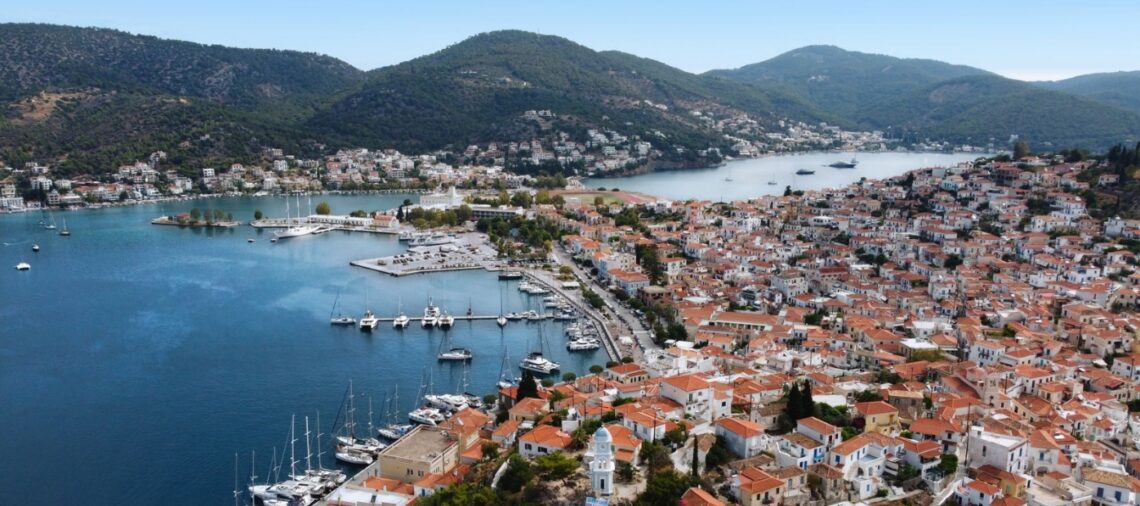I wrote in the article about the idea of a yacht holiday among the Greek islands. It was an experience I lived for five days, at the invitation of GNTO (Greece National Tourism Organisation), aboard a luxury yacht, the Gektor, cruising the islands of the Saronic archipelago between Attica and Peloponnese. I recommend such a holiday to anyone who loves Greece. Even if you don’t have the budget to hire a yacht (my foray was a working documentary), there are other, cheaper craft on board which you can spend a few delightful days at sea, such as catamarans or sailing boats.
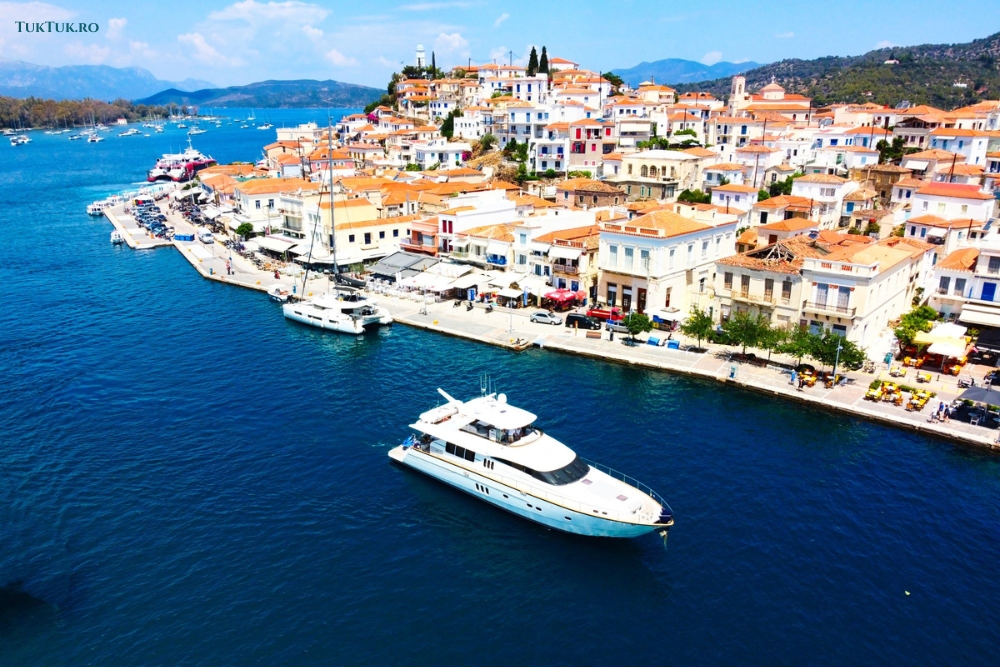
So, let’s take a look at this archipelago of the Saronic Islands, located in the bay of the same name. Because the islands I’ve visited can be transformed into self-contained destinations for a quintessentially Greek holiday within easy reach of the capital Athens. In fact, all these islands – Aegina, Agistri, Hydra, Spetses, and Poros – are places where Athenians either have holiday homes or opt to spend their weekends. The yacht route was as described above, departing from a port in Athens, and the sea trip had another non-island stop in Porto Helli, a place you’ll also read about in a few impressions below.
Yacht itinerary through the Saronic Islands:
Aegina – the island of pistachios and St Nectarios
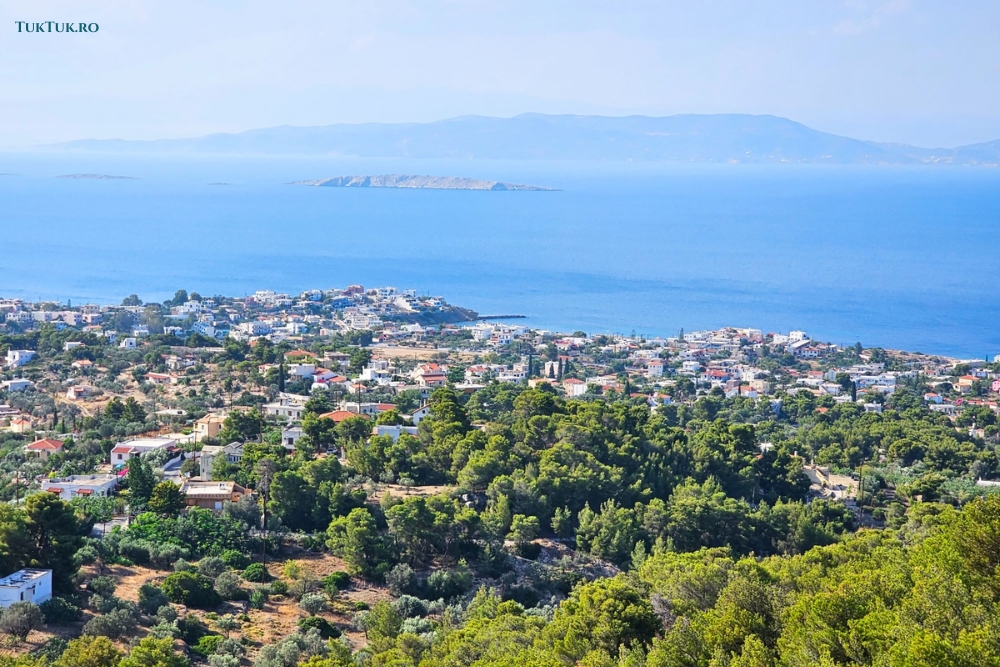
Aegina was the first “Saronic” stop after leaving Athens. I knew about Aegina (you can pronounce it eghina) as the “island of pistachios,” and I had heard something about a saint whom the Romanians revere and who has a monastery named after him here: Saint Nectarios.
I knew that the island was originally called Inoni and that the name Aegina comes from one of the 50 daughters of the river god, Asopus, who became nymphs after being kidnapped by the gods. Zeus, the supreme boss of Olympus, had fallen in love with Aegina and, to keep her away from the wrath of Hera, took her to the uninhabited island of Inoni. Here Aeakos was born, the fruit of Zeus and Aegina’s love affair and the island’s first king. But since the king had no subjects, Aeakos asked his father to… do something. Creative Zeus turned the ants on the island into humans so his son had someone to rule over. The first inhabitants of Aegina were called myrmidons, after the Greek word myrmigi, which means ant.
Legends are nice, but real history also records a glorious moment for Aegina after the Revolution of 1821, when it became (for two years in 1827) the first modern capital of Greece.
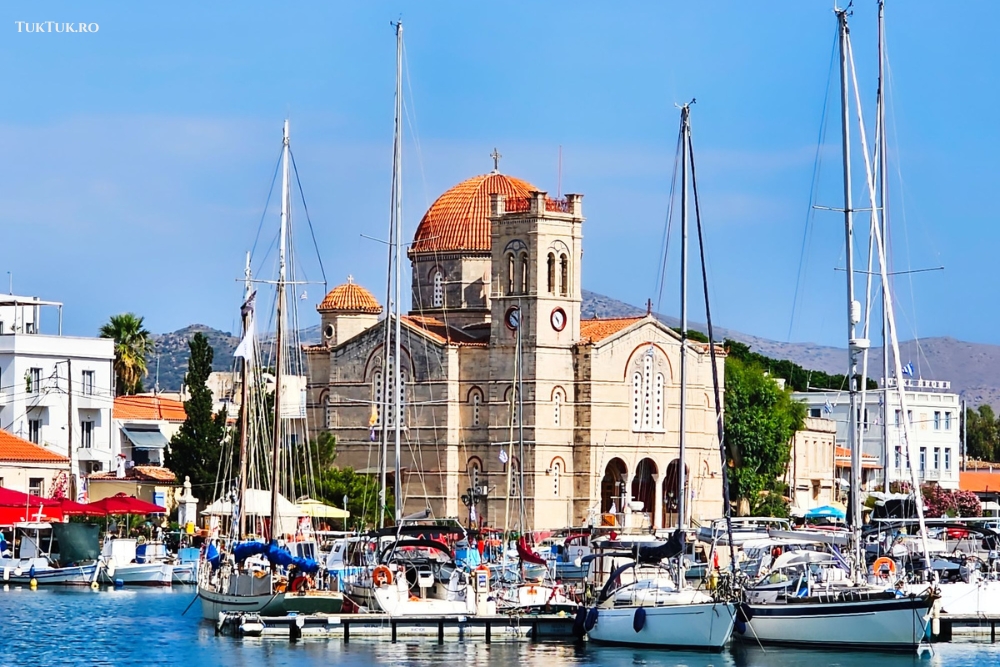
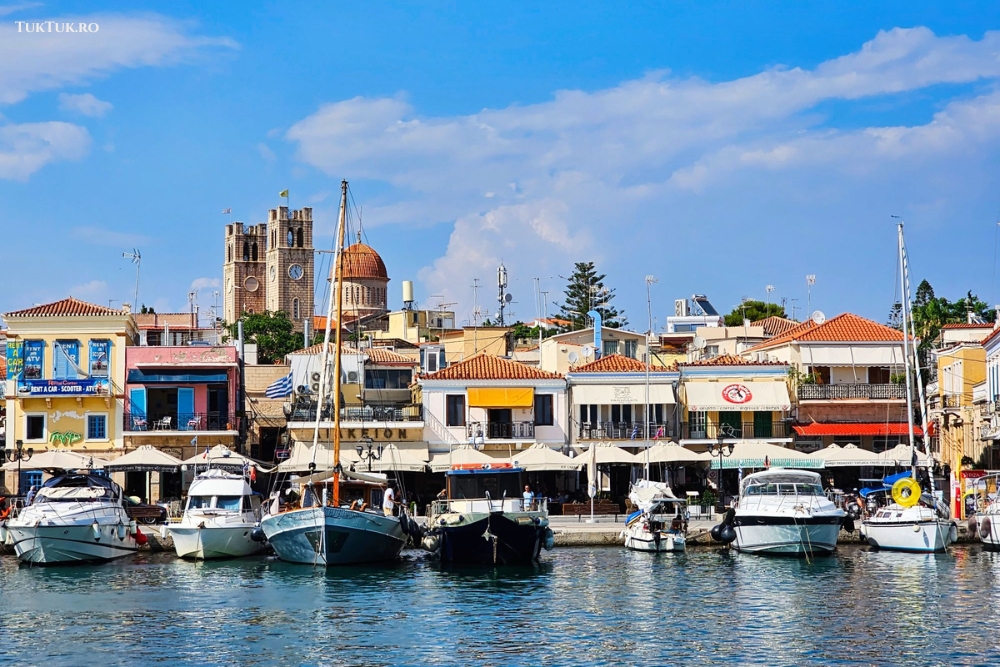

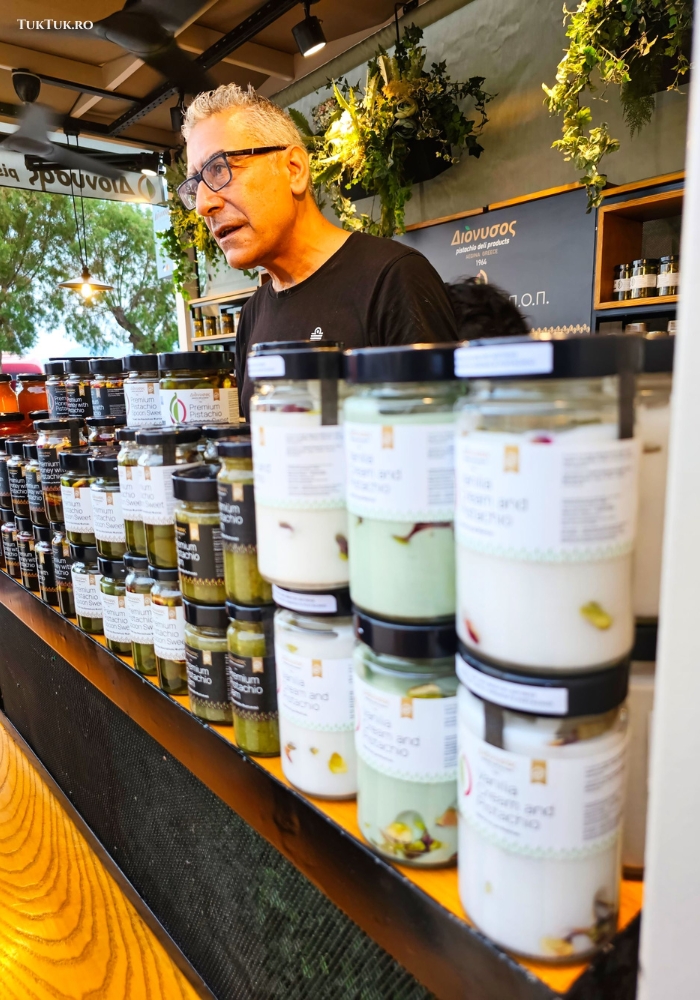
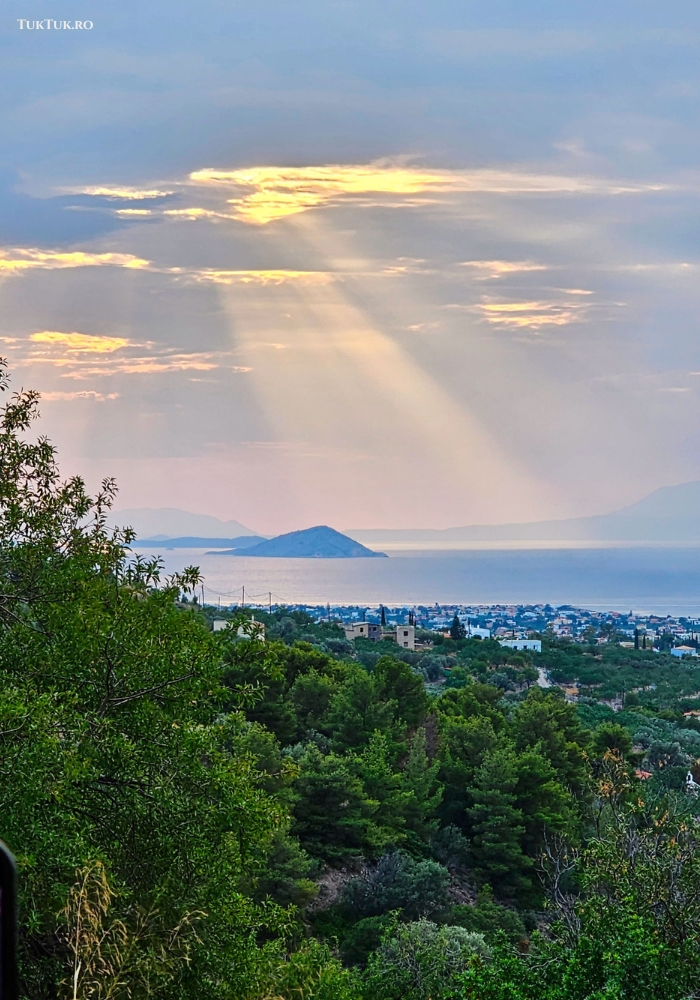
Aegina is very close to Piraeus. It’s practically an hour’s way by sea, after which you anchor in the port of the same name, with its little promenade along which tavernas and stalls selling tasty pistachio products stretch. You wouldn’t believe how many can be made from pistachios and how many dishes can be made with pistachios – only you have to go to Aegina. And by the way, the pistachios here are really tasty (pistachio ice cream reinterprets the concept) – I regret not sourcing more seriously. However, I have found that when talking about pistachios, the Greeks no longer call them by name but define them by a term that roughly translates to… aeghinic.
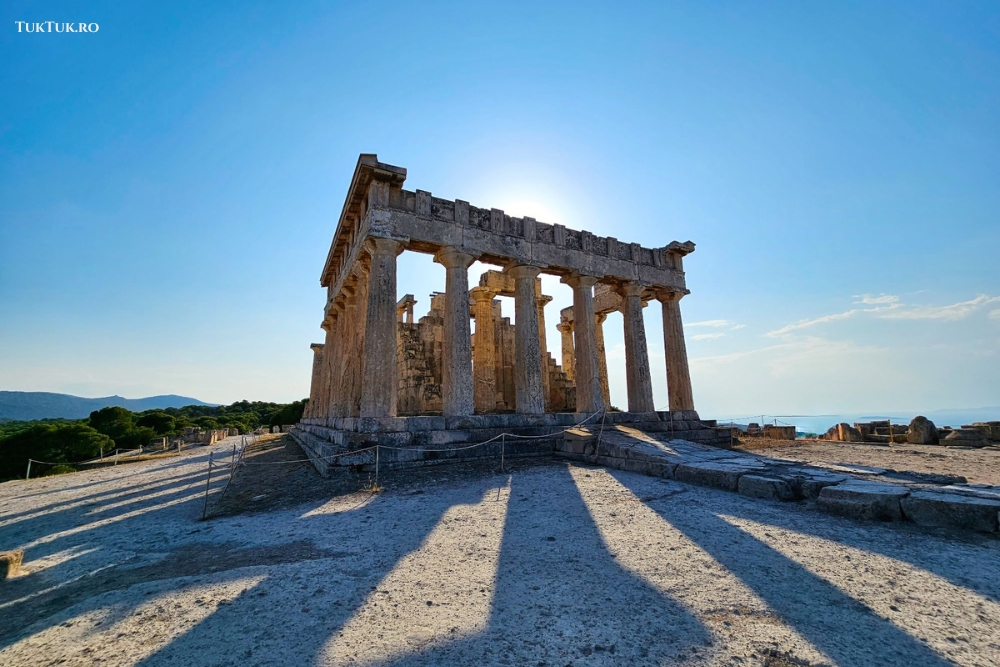
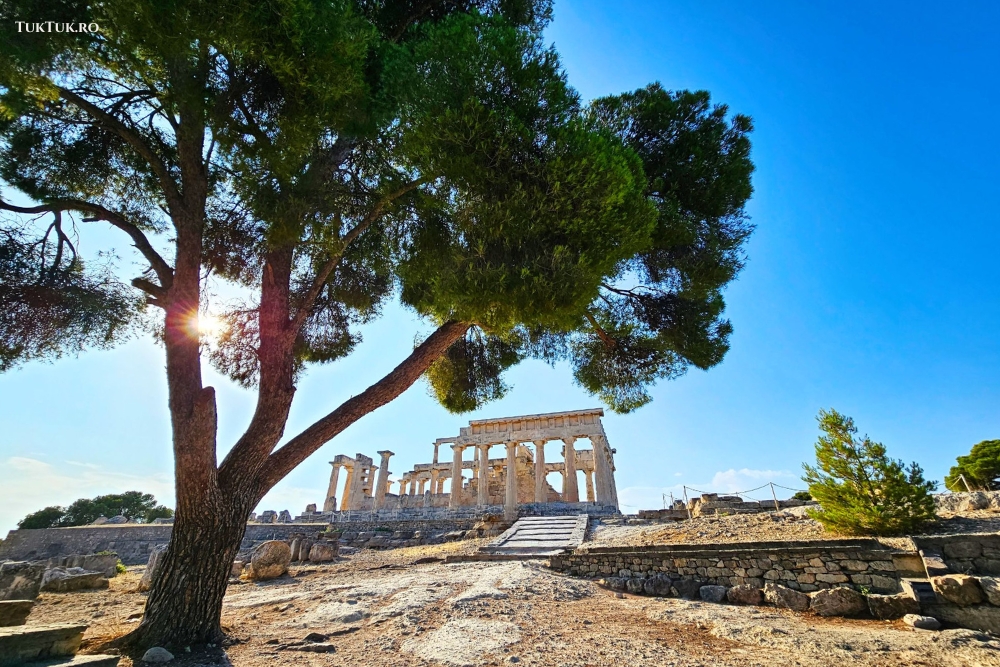
Although a relatively small island, Aegina has many places worth visiting. I saw two, probably the most important ones. The first is the Temple of Aphaia, built-in 500-490 BC in the Doric style and dedicated to the goddess Athena. It is said to exude incredible energy because it forms two imaginary isosceles triangles: one with the Temple of Poseidon at Cape Sounio and the Temple of Hephaestus in Athens, the other with the Temple of Apollo at Delphi and the Parthenon on the Acropolis. Some truth there must be, because once you’re around it, you’re overcome by a state of complete tranquillity, which can be all the more pleasurable when you catch the sunset here, with the rays creeping through the ancient columns. Bonus: lots of cats.
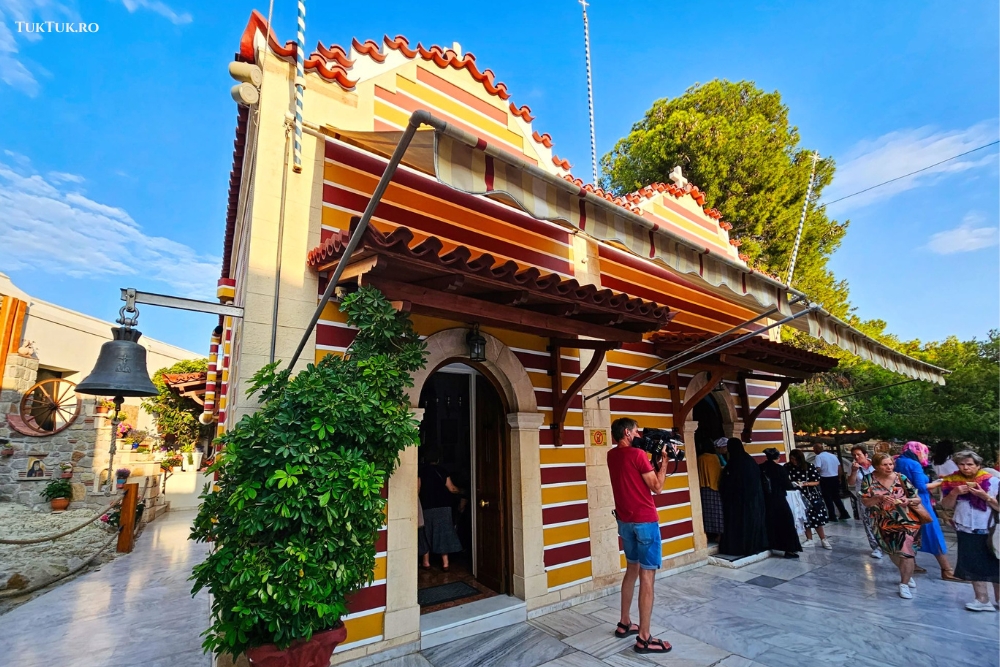
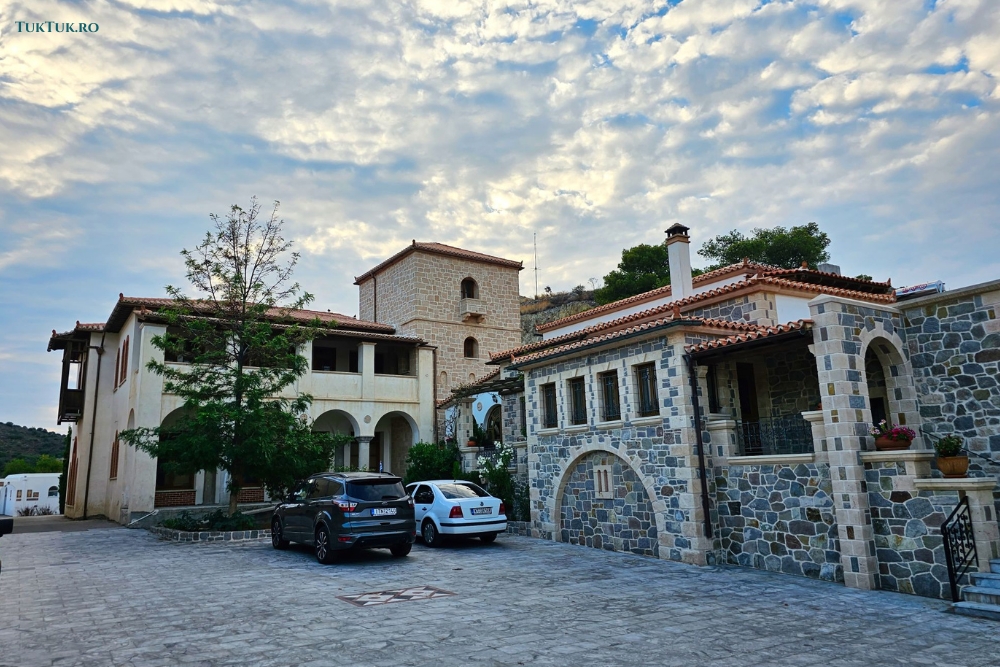
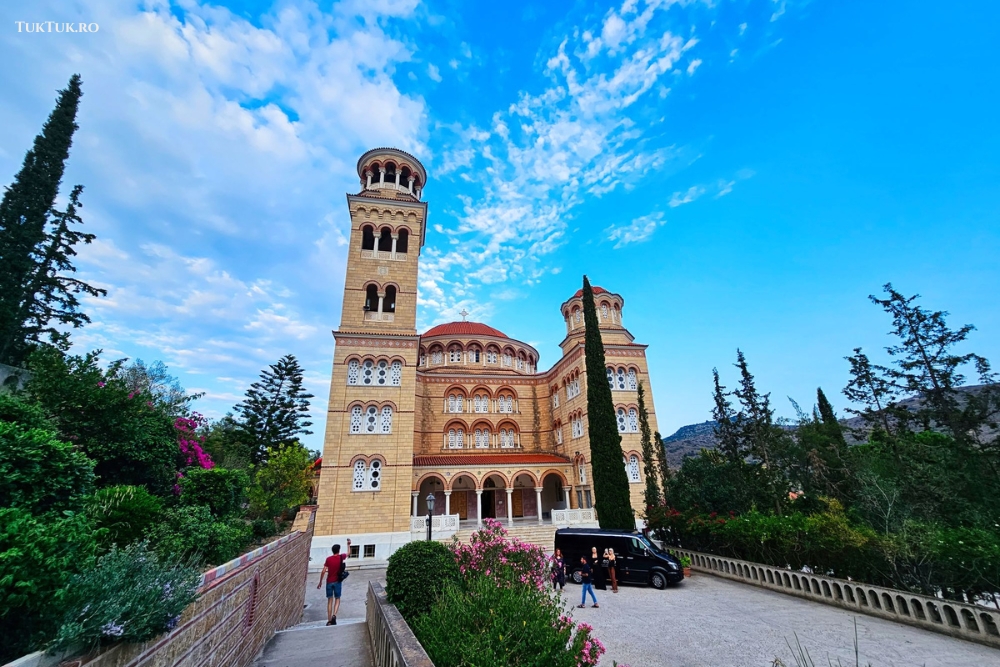
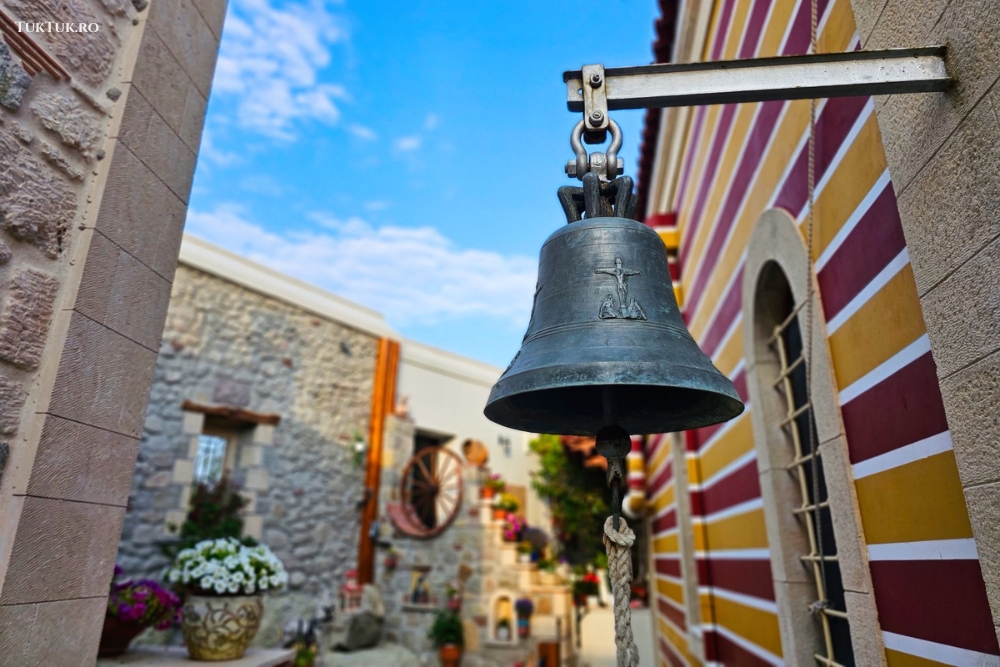
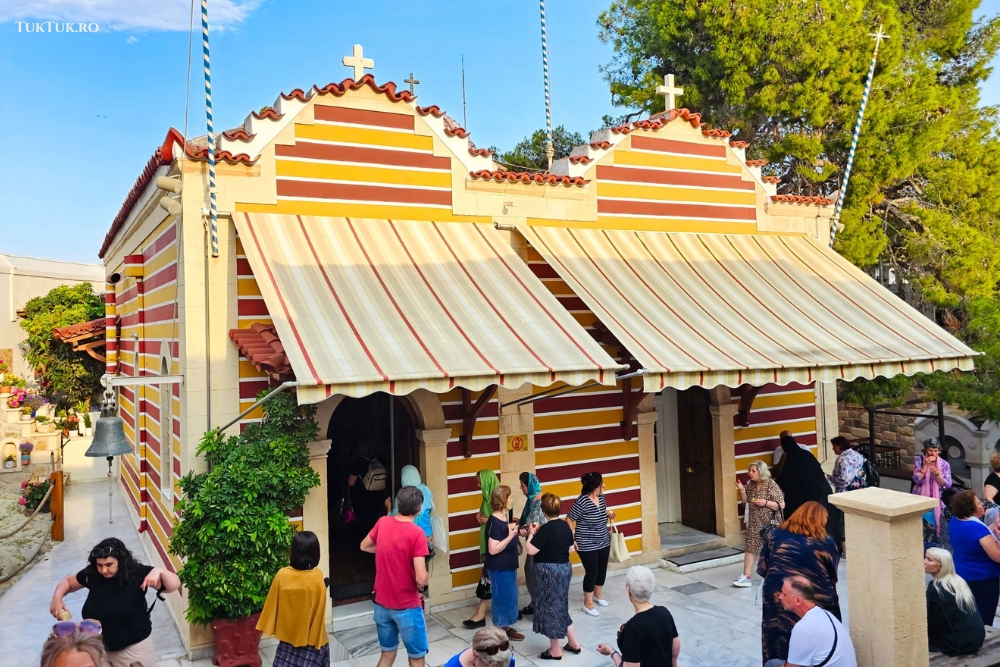
The second sight we visited in Aegina was the Monastery of St Nectarios, founded by the bishop in question around 1904-1910 at the request of several nuns. The thing about Nectarios goes like this (the parenthesis is as much for the pious as for those curious about the extent of his fame): Agios Nectarios was an early 20th-century priest and educator known for his healing abilities.
In fact, legend has it that he drove the demons out of a man and “brought” the rain when the locals asked him to do so following a drought. Enough for him to become famous and go viral as the bringer of signs from God. November 9 remained St Nectarios’ day, and his monastery became one of Greece’s most visited holy places. Nectarios lived in the monastery for 13 years and was buried there in the shade of a plane tree.
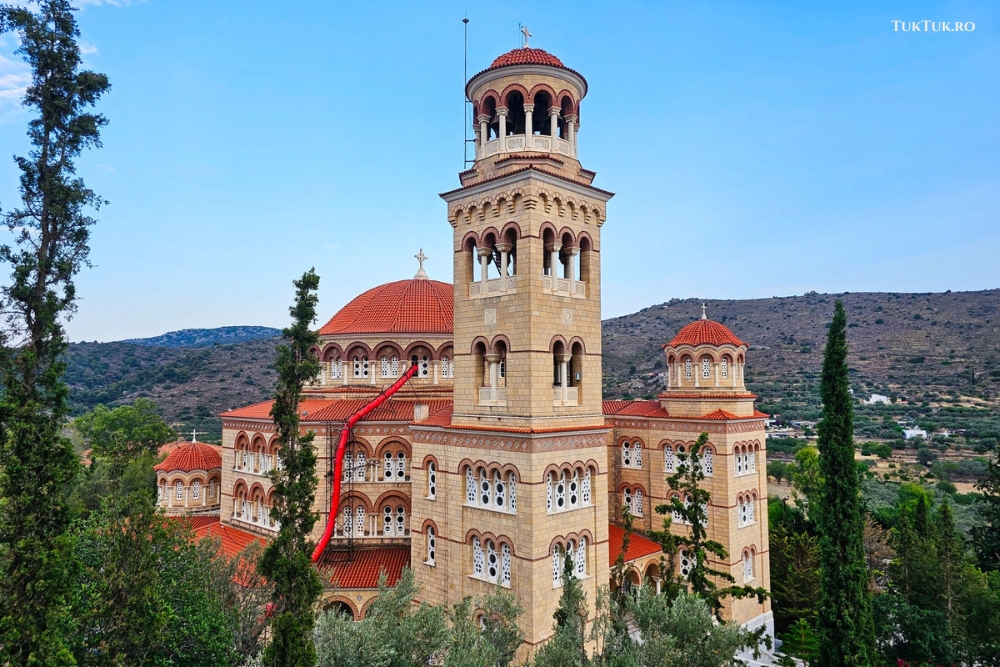
Inside the monastery are two small chapels that house the tomb and the holy relics. The chapel, which was the house in which he lived, is behind these chapels and is open to the public. Below the monastery, an imposing church was built, also dedicated to St Nectarios, with two tall bell towers.
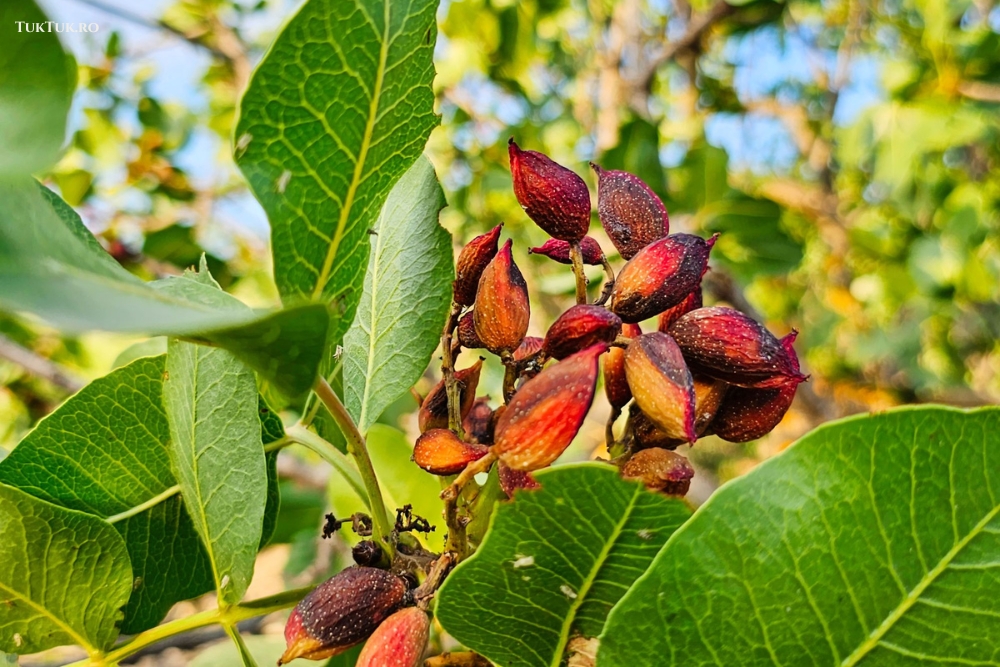
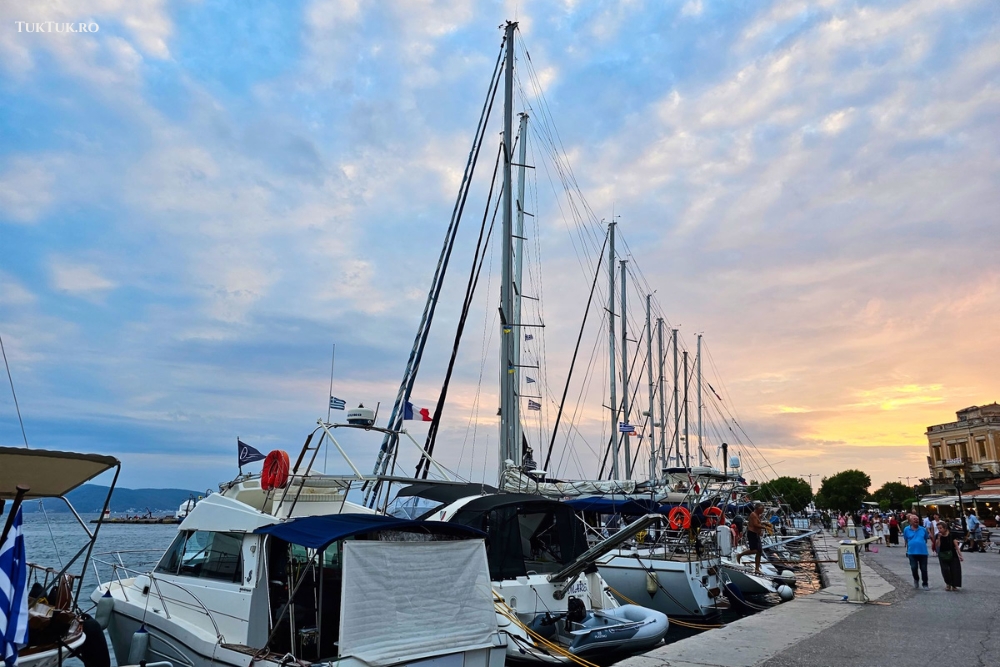
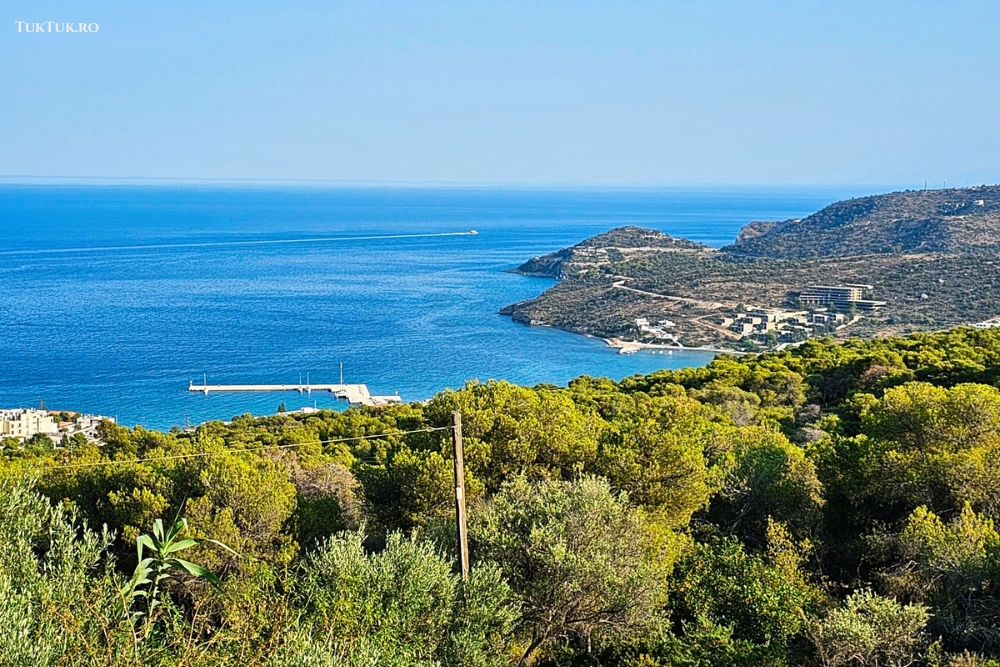
For me, the hours of sightseeing on Aegina were limited by the yacht’s departure. Still, for those who get here, I recommend other beautiful sights that should not be missed: the house of Nikos Kazantsakis (the famous Greek writer who “gave birth” to Zorba), the Temple of Apollo, the Tower of Markellos and the Museum of Archaeology (the first in modern Greece).
Agistri – the little pine-covered paradise
Agistri (or Angistri or Agkistri) was a short ‘stop’ on the Saronic periplus. I pulled up at the pier for two hours to enjoy a coffee at a restaurant near a nearby beach, so I didn’t get a chance to “browse” extensively through the storybook of this island, the smallest in the Saronic archipelago.
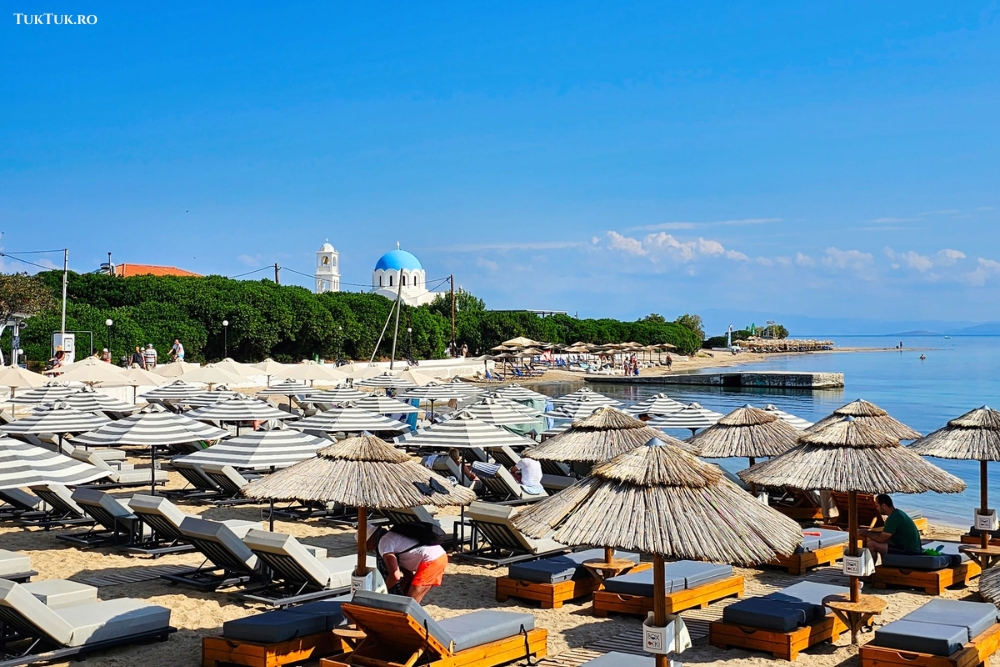
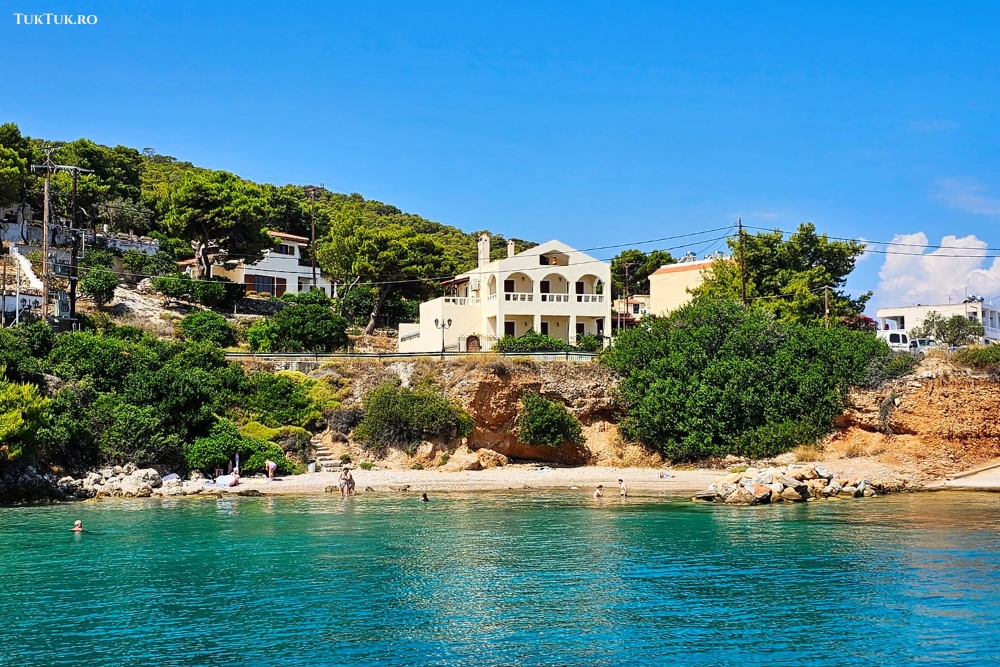
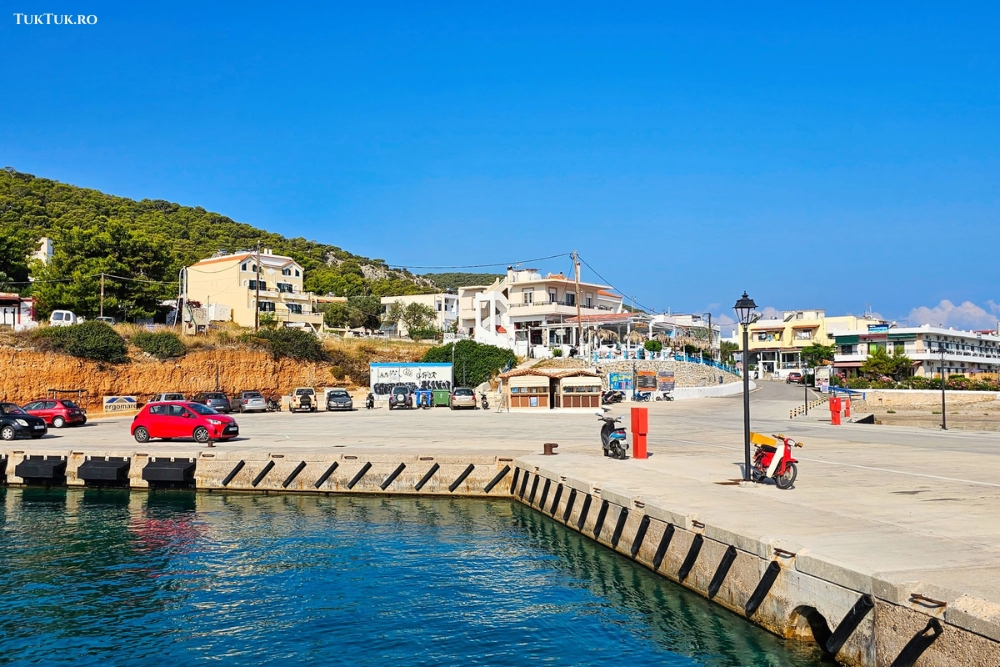
What I do know, however, is that Agistri is home to a few traditional villages and several other beautiful beaches surrounded by pine forests. Agistri is not a cosmopolitan island, so don’t expect to find anything but peace, relaxation, and full contact with nature and its beauties here. Megalochori is the port and main town of the island, not as touristy as you might expect.
Suppose you set off on a hike and start climbing the slopes of the hills of Agistri. In that case, you may end up in the village of Metochi, where you will have wide views of the surroundings. 2 km from Megalochori is the village of Skala, which could be called the central point of tourism in Agistri, where you will find accommodation and taverns. The main beaches of Agistri are Aponissos and Dragonera.
Hydra – island without cars, but with mules and cats
As the yacht entered the harbor of Hydra (which has the same name), I realized that this island had a special feature: I didn’t see any cars. Indeed, on Hydra island, cars – and other motorized ‘relatives’ – are banned, replaced by mules, donkeys, and horses. The port – Hydra’s main settlement and, as far as I understand it, pretty much the only one, the others can hardly be called villages – perches its houses on the rocky relief, so it looks like a classic Greek “beehive.”
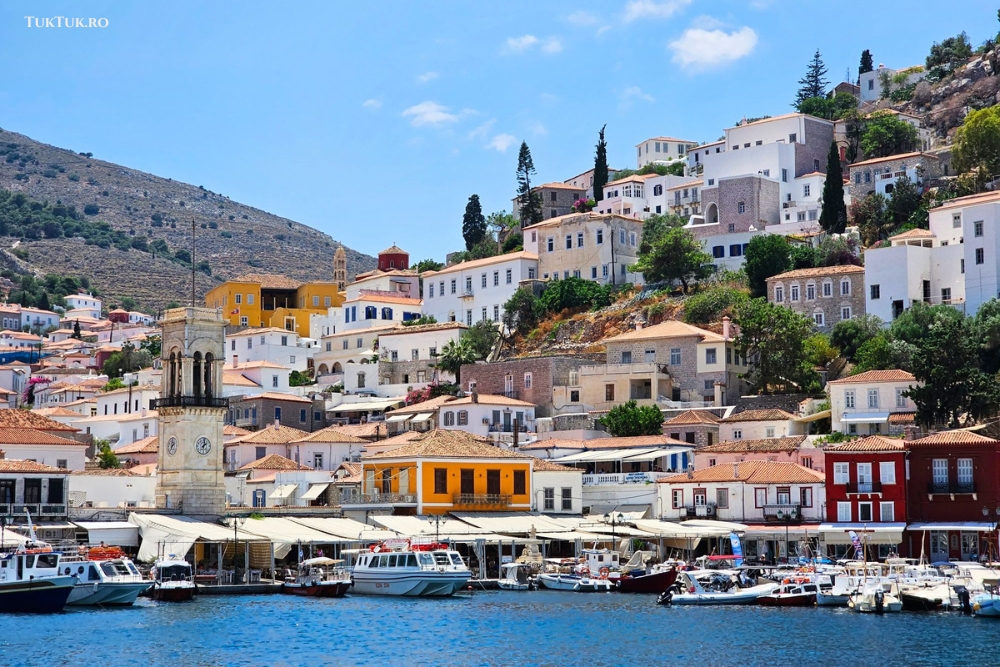
Within an hour of anchoring, I was in the office of the island’s mayor, telling us about Hydra’s history and how life is conducted here, where people don’t use cars. The mayor was talking about how Hydra was the driving force behind the Greek Revolution of 1821 after, previously, in the 17th century, to be exact, the island had acquired a strong merchant fleet and became a major “player” in the Mediterranean.
Except that…, in 1792, the plague broke out, a large part of the population was exterminated, and the survivors moved to the mainland. But they quickly returned and put Hydra back on the mainland’s naval map with an even larger fleet of about 130 ships. The anti-Ottoman Revolution caught the island in a somewhat unfortunate context, as it was in a privileged position vis-à-vis the Turks. Eventually, however, the good won out, and the Hydriots (yes, that’s what they’re called!) seriously staked their claim to final victory, especially with the help of their ships, backed by the Commercial Marine Academy, which had monopolized shipping in the Mediterranean.
In fact, the heroism of the Hydra ships became so well known throughout Europe that it is still spoken of today in glowing terms, especially about the shipowners Andreas Miaoulis and Lazaros Koundouriotis, who contributed significantly to the victory of the Revolution.
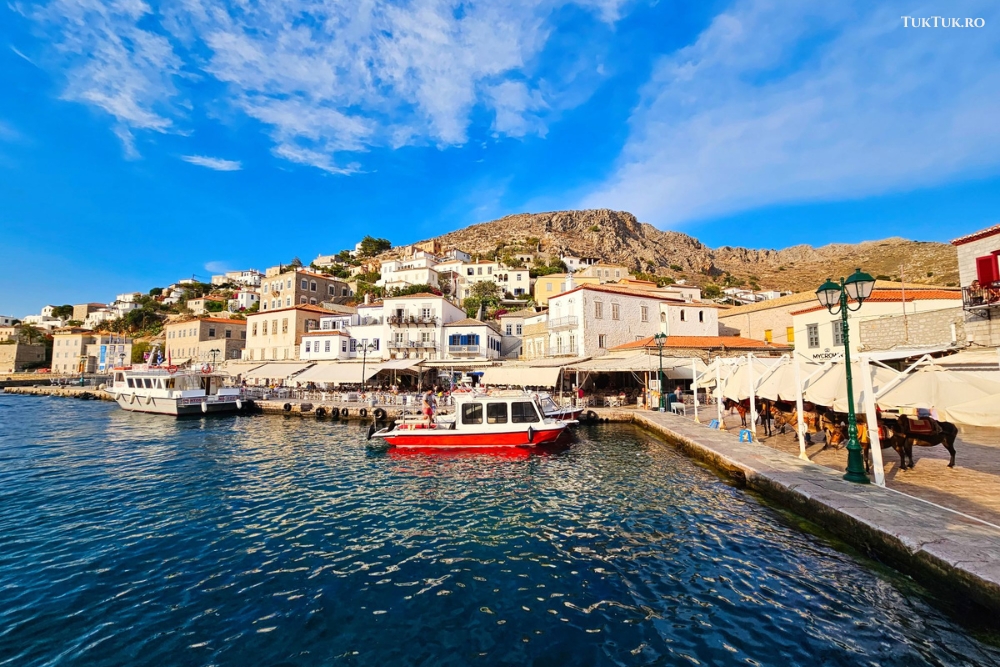
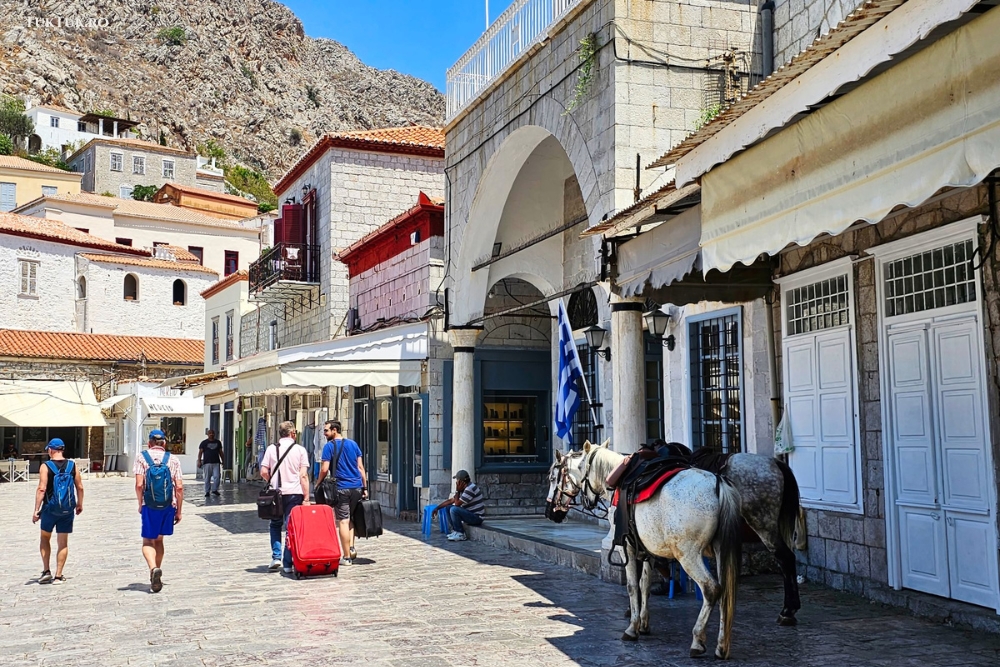
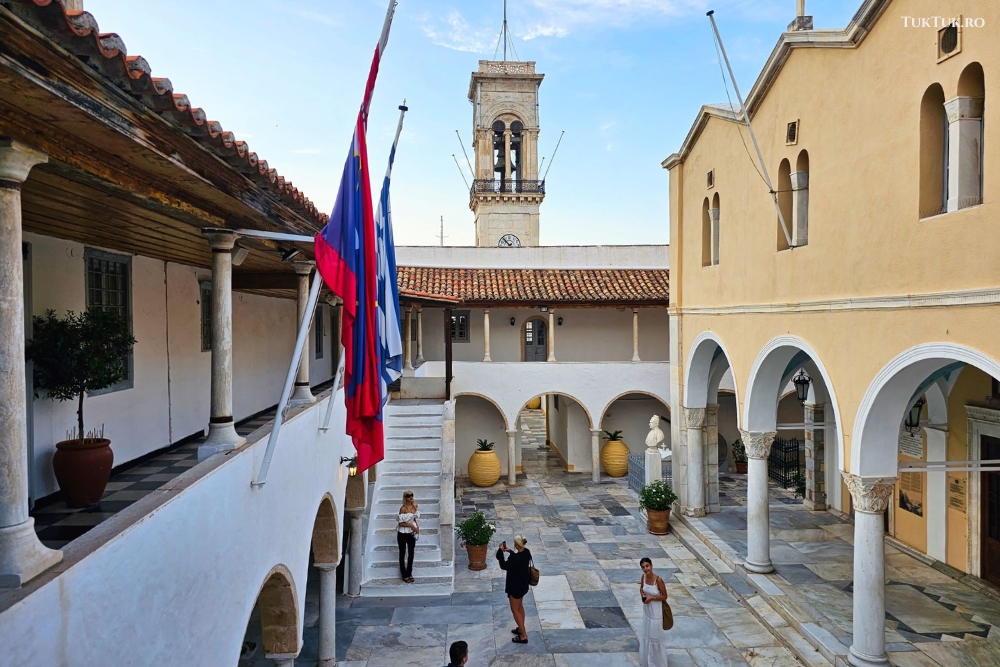
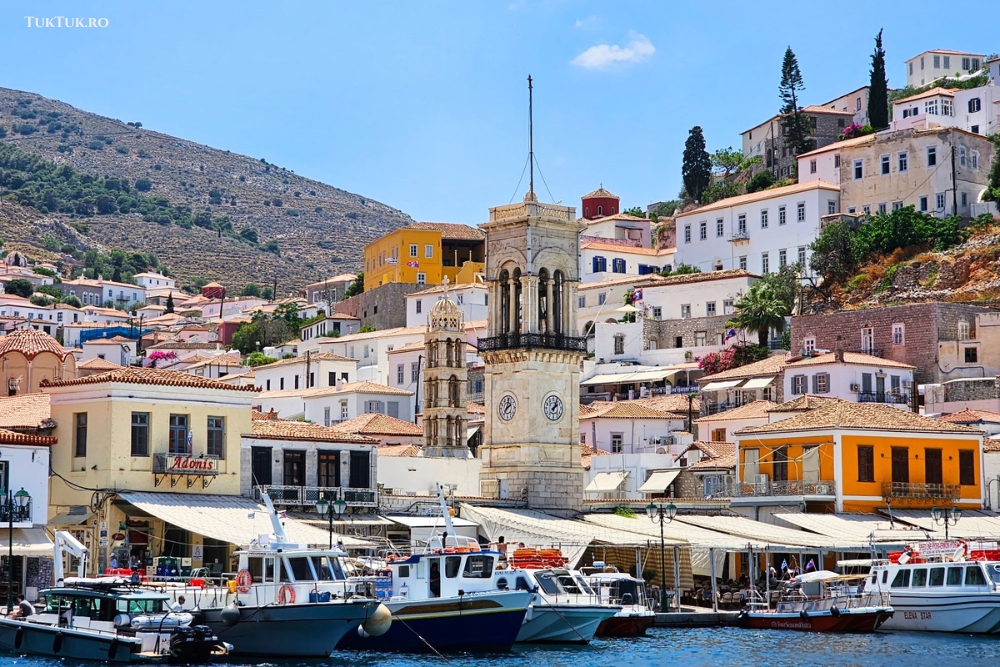
But enough about the history of this island, which takes its name not from the horrible multi-headed monster of Lerna but from the springs of water on its territory. What did we do in Hydra? First of all… we ate at a taverna that I recommend without a second thought: Psaropoula. The food here is fabulous, and I won’t insist on more descriptions beyond a few photos.

To explore Hydra (I’ll limit myself to the port city, I didn’t go outside its “borders”), you need mules or… good physical condition. Mules do it all: carry tourists’ luggage up the sloping paths, carry the bags of household rubbish put out at the gate by all the locals, carry people with medical problems, and so on. I’d call the mule the main character of Hydra, but other creatures define the island’s landscape: cats.
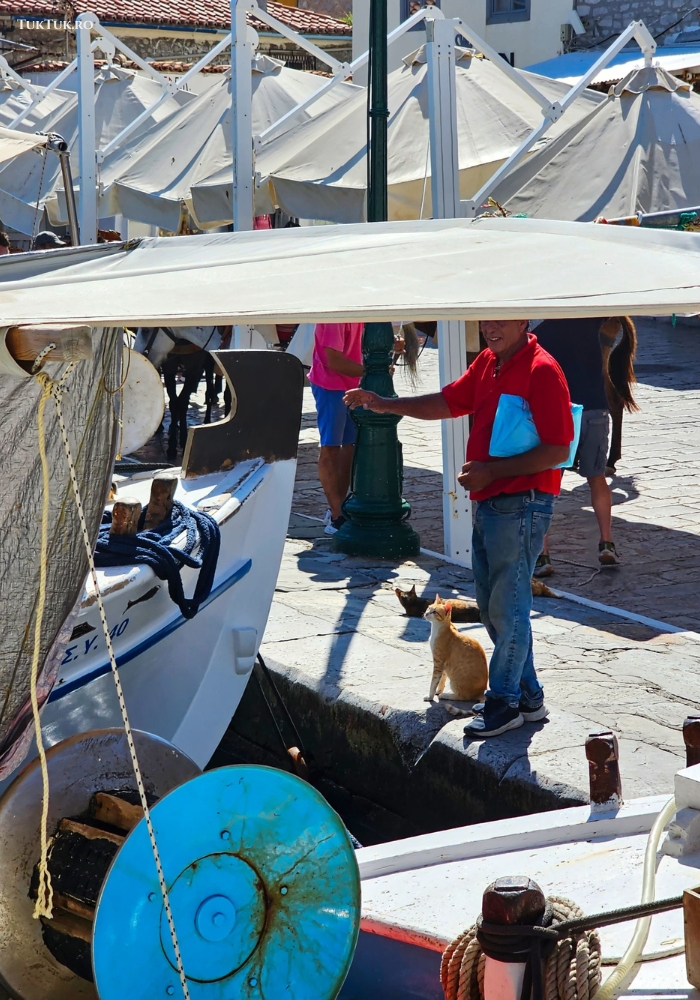
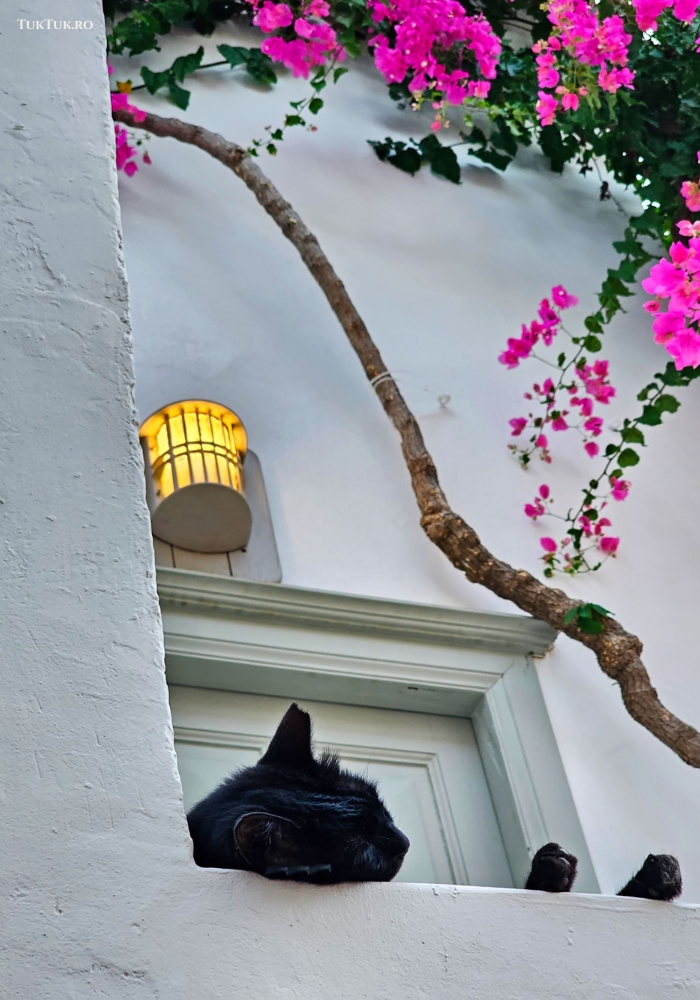
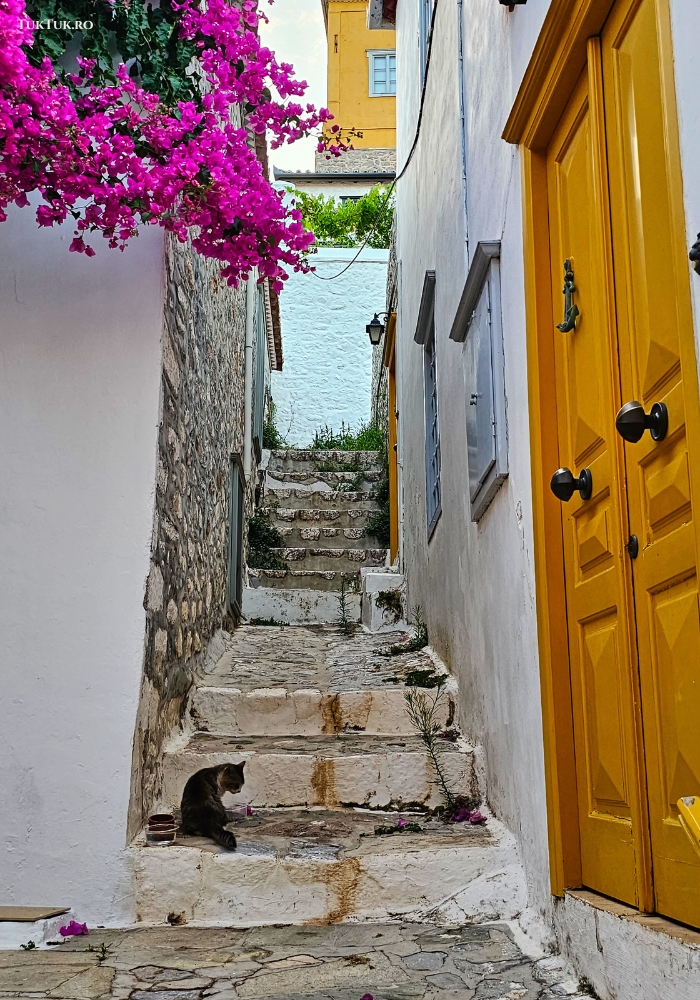
I’ve never seen so many cats in one place, other than Istanbul. But there the city has a larger population than Romania. Hydra is home to about 2,500 people who have to look after over a thousand cats, which you see everywhere. And they do! The mayor said the cats are given maximum attention, especially in winter, when it’s harder for them to feed because there are no tourists. In Hydra, there are cats everywhere you turn your head, and what’s more, they are extremely friendly and clingy. Finding one on your lap when you’re eating or clinging to your back when you return to the yacht is not out of the question.
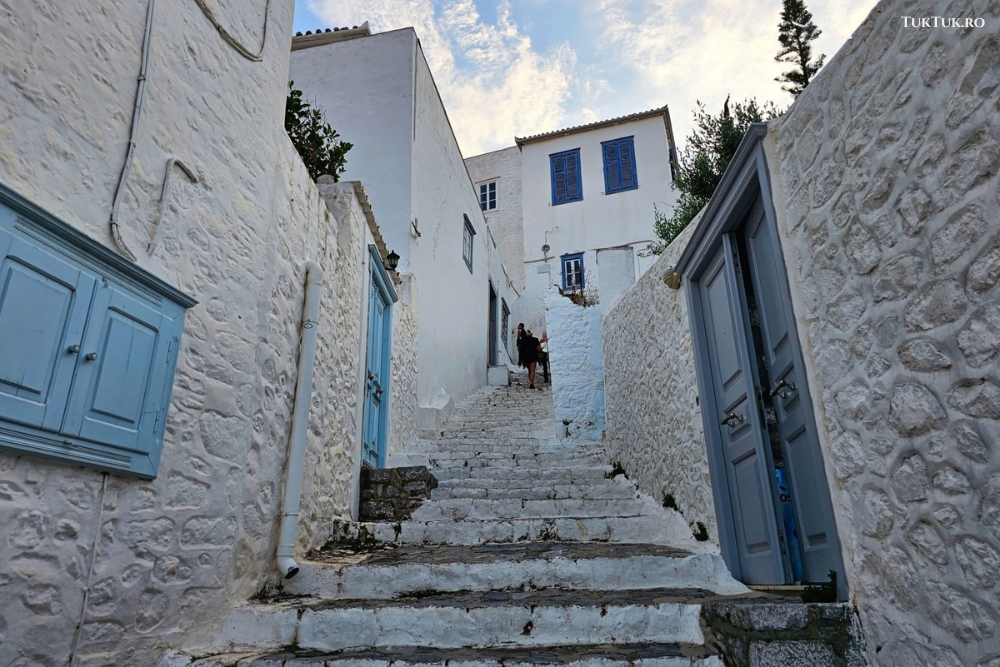
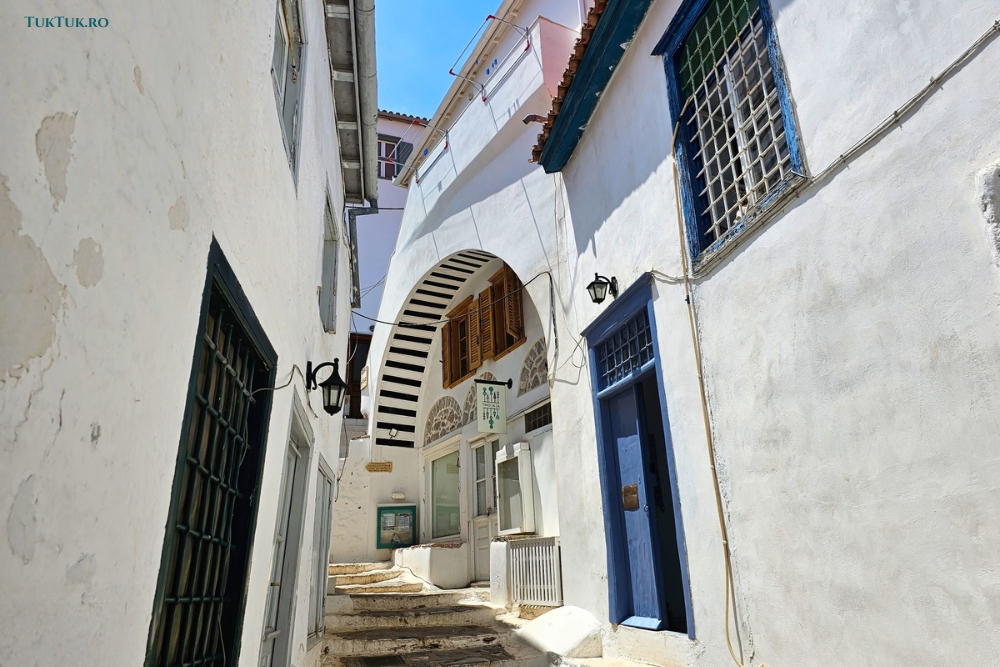
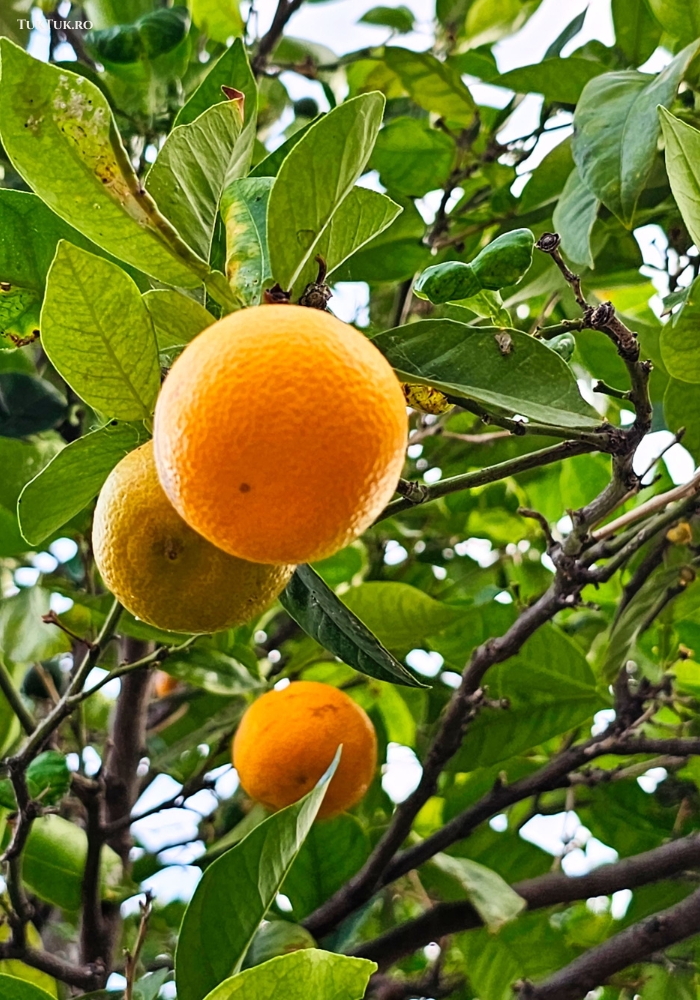
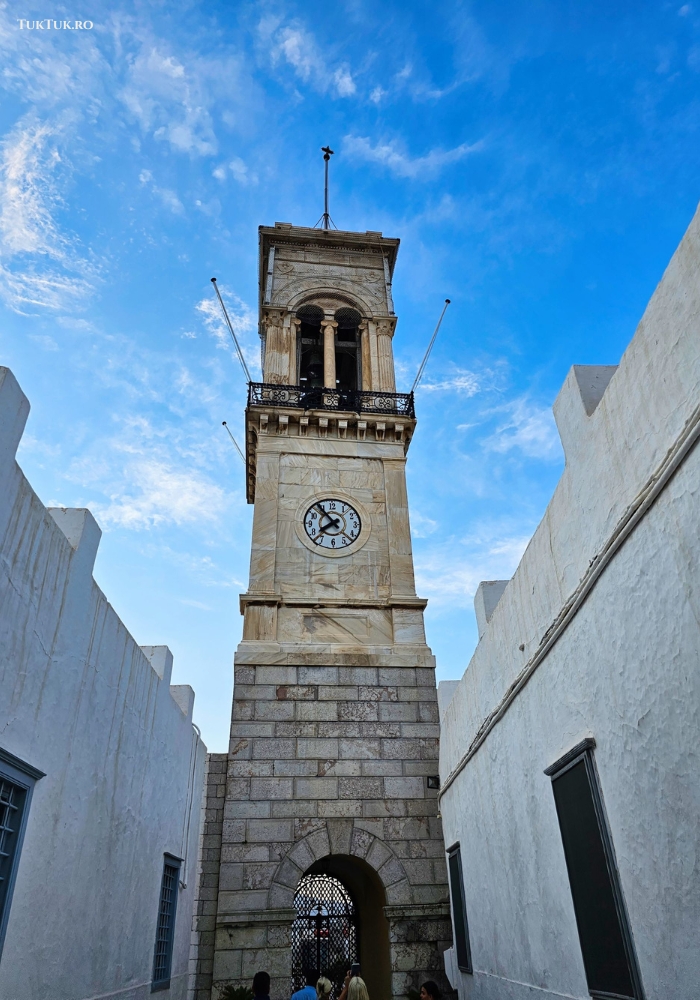
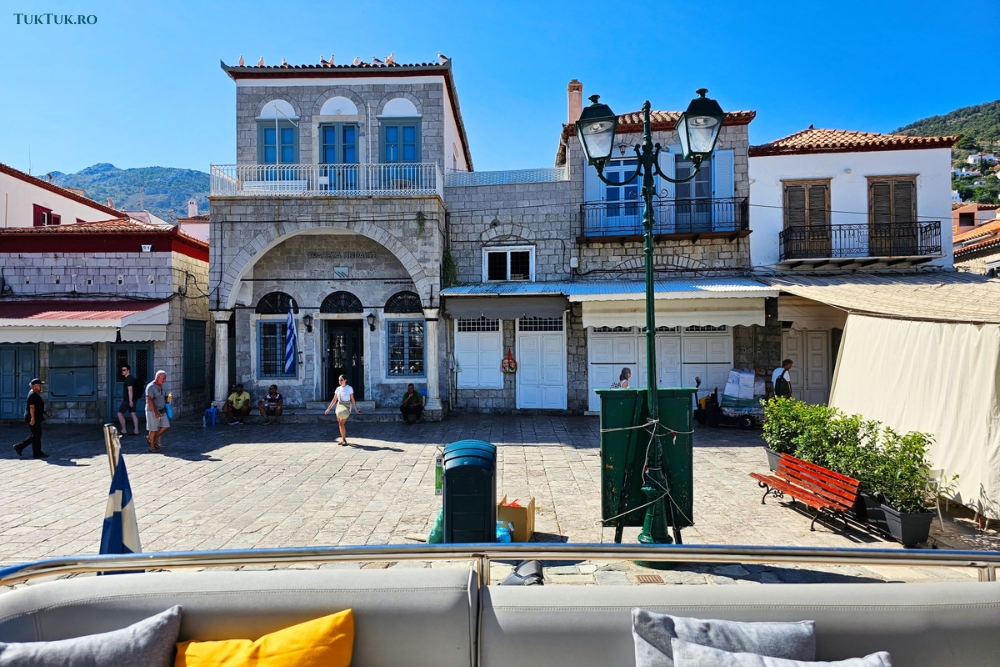
There’s not much to see on Hydra, an island I find hard to fit into a tourist pattern. The fact that you don’t have much to get around on it (apart from mules) doesn’t recommend it for much activity. Apart from the harbor, you don’t have any other developed settlements is another seemingly anti-tourist ball. The fact that it has no sandy beaches, just pebbly strips on which you can lay your sheet at the edge of the crystal clear water, is another feature less friendly to the idea of a multi-day holiday.
Nevertheless, Hydra has a charming atmosphere that seduces many. Let’s not forget that the island has been a retreat for the likes of Aristotle Onassis, Maria Callas, and Leonard Cohen. The famous Canadian singer, for example, lived on Hydra for more than 10 years, where he also bought a house that is now a major tourist attraction. Here, Leo lived his famous love affair with Norwegian Marianne Ihlen, to whom he dedicated some of his songs, including the famous So long, Marianne, Hey, that’s no way to say goodbye, and Bird on a wire.
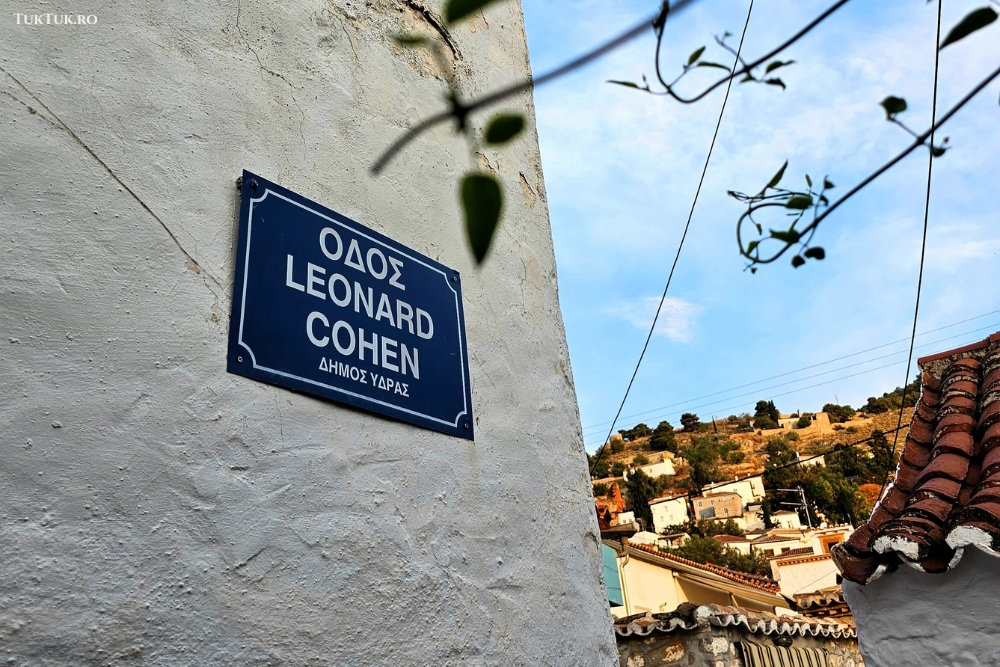
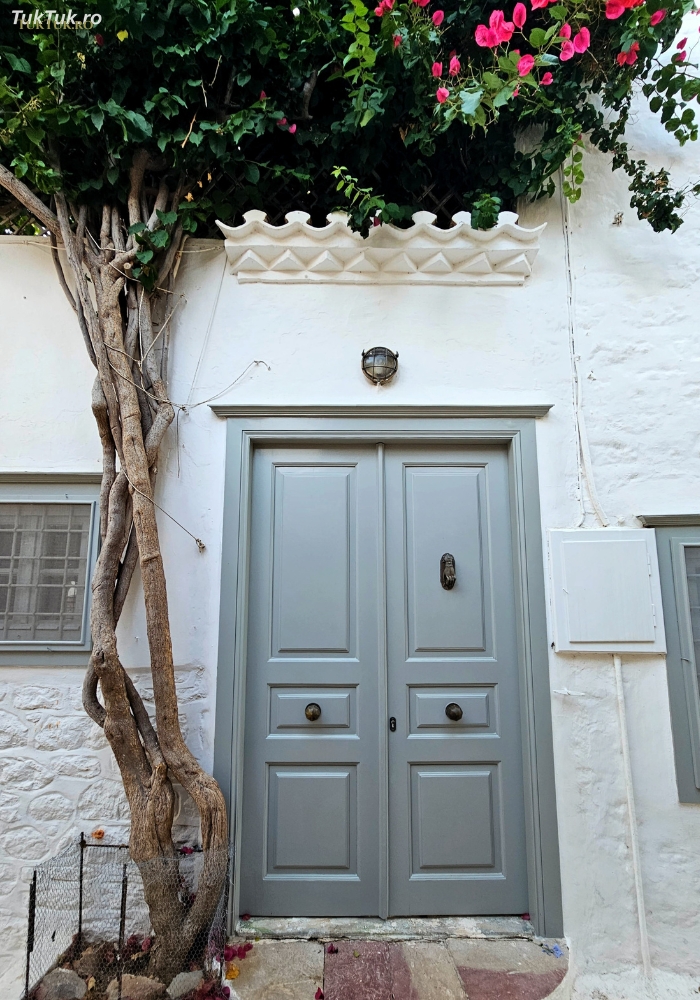
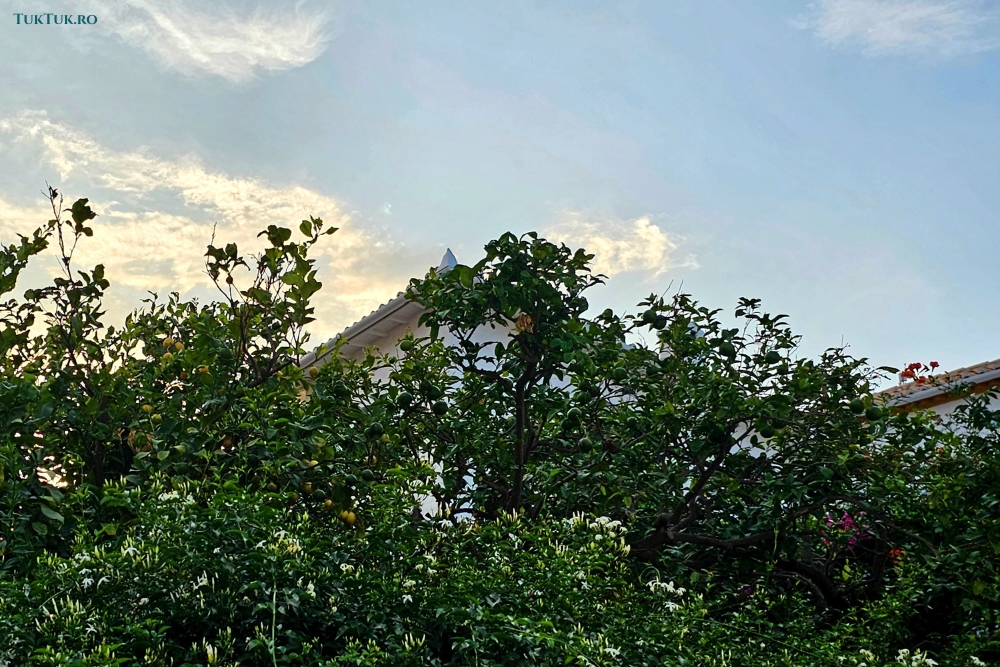
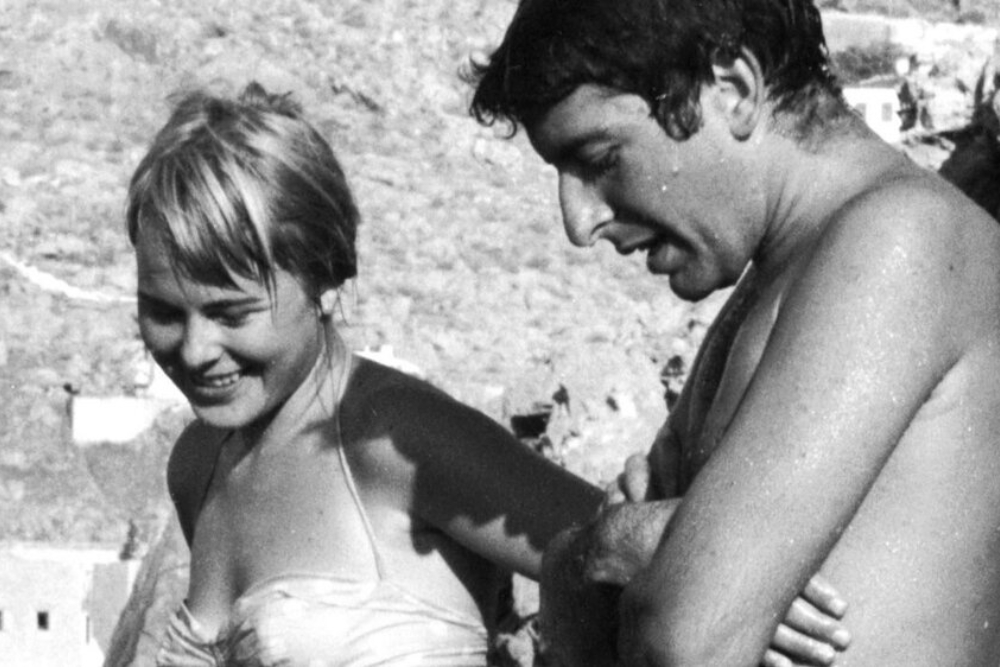
The house can be seen from the outside, on a walk along the sloping alleys, past the countless cats, but also past other little gems, starting with the Church of the Assumption of the Virgin Mary, with its tall bell tower made of pure Tinos marble, which dominates the harbor landscape and is the main architectural landmark seen from the sea. The church was built in 1643 and housed a small ecclesiastical museum, with the Town Hall offices in the same courtyard.
Several small monasteries (Agia Efpraxia, the Prophet Elijah, Agia Triada, Agia Matrona) fill out the island’s ecumenical landscape, joining other landmarks such as the Academy of Merchant Marine. Melina Merkouri Auditorium and the Koundouriotis family house-museum.
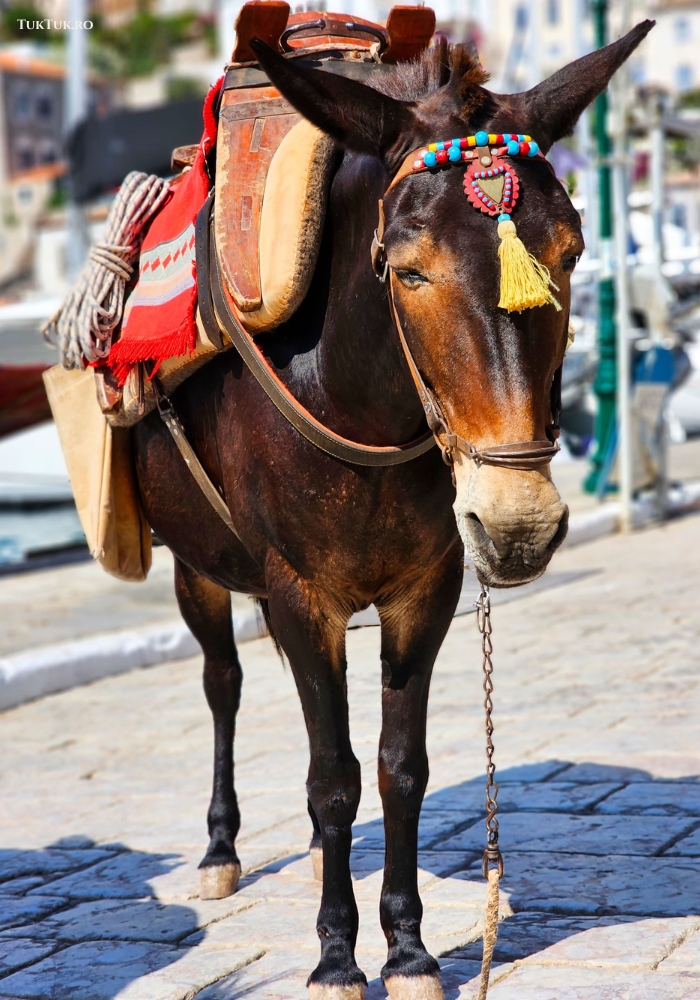
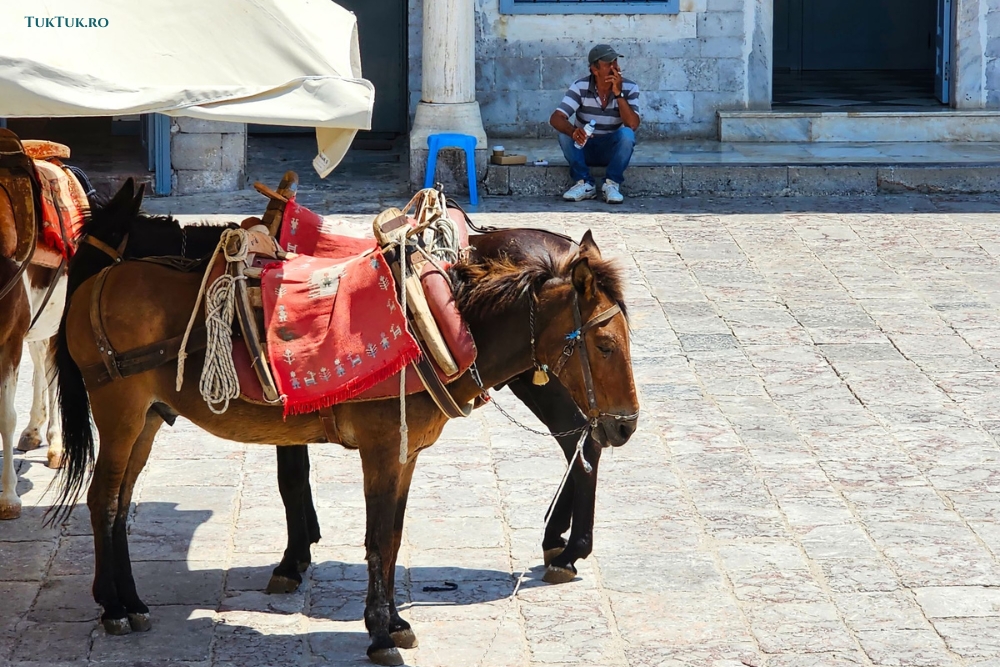
I’ve already mentioned that Hydra has no vehicles (besides some garbage trucks and other utilities). But the seemingly bizarre features don’t stop there. It stems from the island’s status as a Preserved National Monument, granted in the 1950s, which imposes several restrictions. One of them is that work taking place on Hydra must conform to the methods and style used around 1800. In other words… no new buildings are being built on Hydra; only old ones are restored and preserved, with the idea that future generations will enjoy them.
A visit to Hydra is like stepping back into history. Anyone who renovates a building not only has to seek planning permission but also approval from the archaeology department, which maintains regulations governing architectural conservation. For example, you’re not allowed to use metal in restoring windows and doors, only wood.
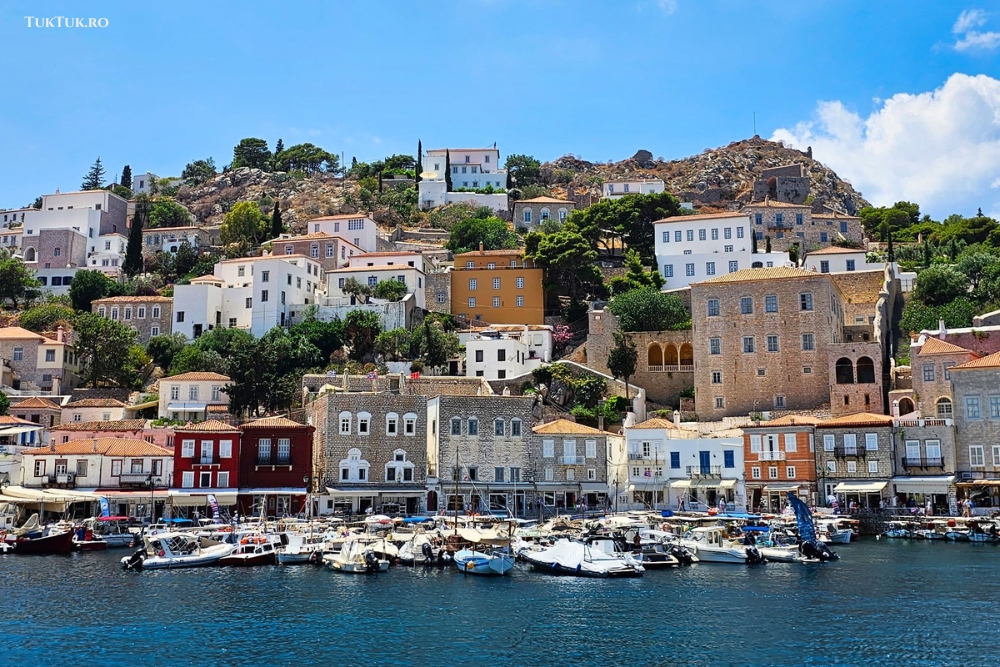
Another interesting thing visitors notice is that there are no swimming pools on the Hydra, as they are technically prohibited by the conservation order. However, a few exceptions applied to properties that were originally built with open cisterns – those rainwater collection tanks – before the 1950s. One is the windmill pool, another – the sponge washing pool at Bratsera. There was a brief period in the early 2000s when it was possible to legalize some pools, but since 2010 they have been completely banned.
As for motor vehicles, they are banned by national decree. “Wheeled vehicles” have no place on Hydra – cars, bicycles, mopeds, motorbikes, etc. That’s why there are no conventional roads or highways on the island and no vehicle rental companies. The only exceptions are emergency vehicles – a fire truck, an ambulance, and garbage trucks, which operate under special licenses. These bans mean Hydra has one of the largest herds of working mules in the world to transport everything from groceries to furniture and building materials.
Hydra, seen from TukTuk :
Porto Heli – a continental “stop” and a holiday option
I left Hydra spellbound, and not because I’d seen the heads of any monsters, but because this time-hardened islet has the grace to completely envelop you in its story. So our yacht set off across the calm sea to our next stop, this time a stop on the mainland at Porto Heli.
Porto Heli is a small town in the eastern Peloponnese, a cosmopolitan port around which are several beaches nestled in secluded coves, charming enough to attract Greek tourists, especially Athenians who have holiday homes in the area, built after 1970 when it was just a small fishing port. To be fair, now that I’ve seen it “briefly”, I can say that if you want a unique holiday in Greece, in a place where you won’t meet too many Romanians, Porto Heli can be an interesting option. Especially since the place is very conveniently located if you want to visit tourist, historical and cultural sights, such as Ermioni, Mycenae, Nafplion, or Epidaurus, which are within walking distance.
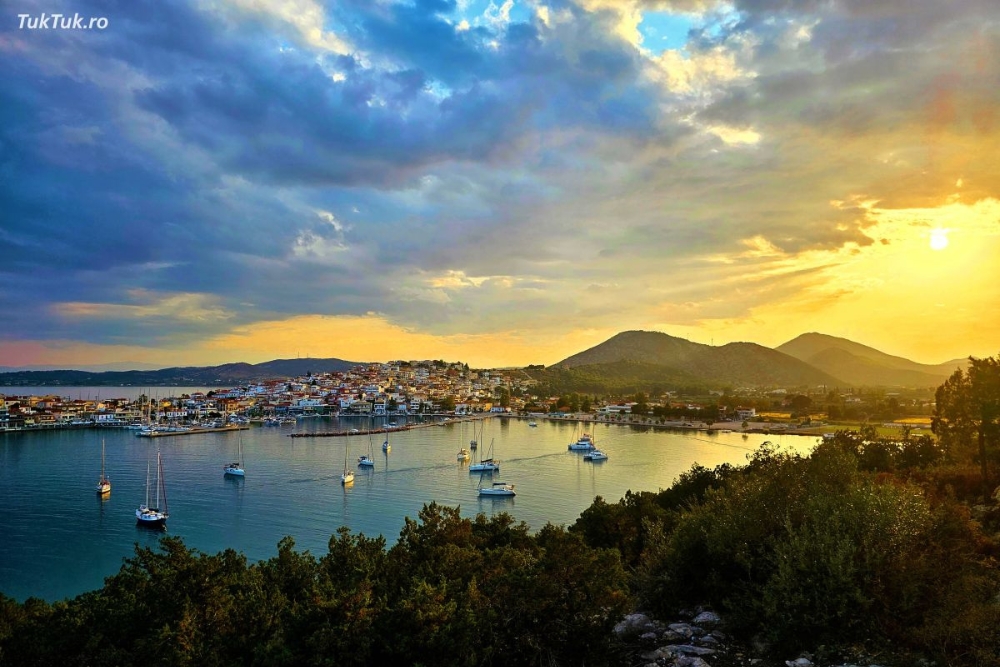
In fact, we even arrived in Ermioni, led by the cosmopolitan vice-mayor of Porto Heli, who is not shy about showing off her tattoos and young spirit. A sunset from a beautiful location, a cocktail in a bar “with a view”, then a dinner show in a seaside restaurant in Porto Heli – enough to give me an idea of this intensely Greek region.
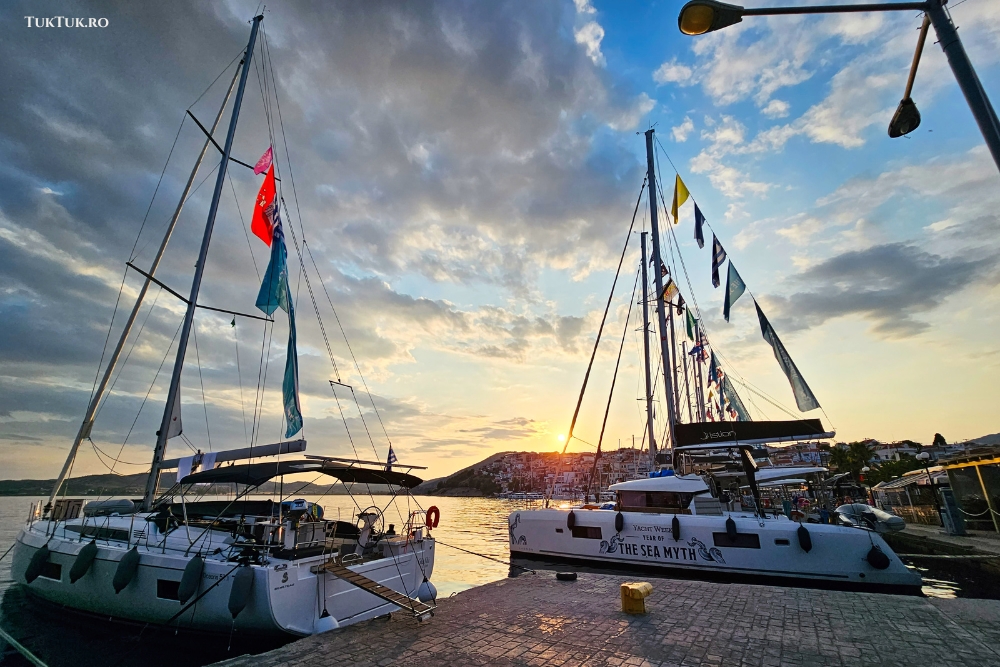
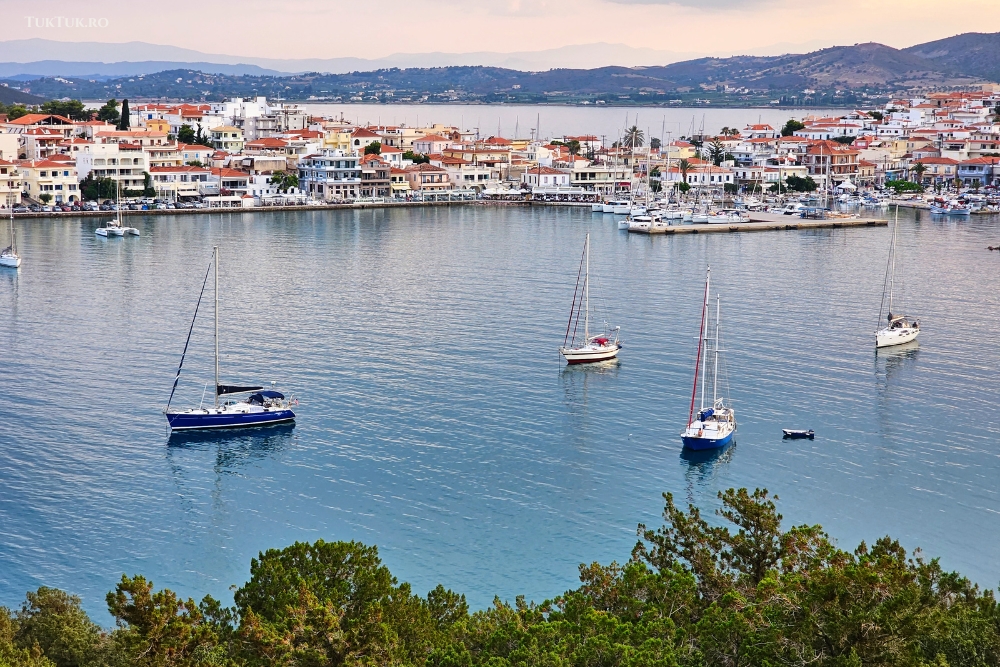
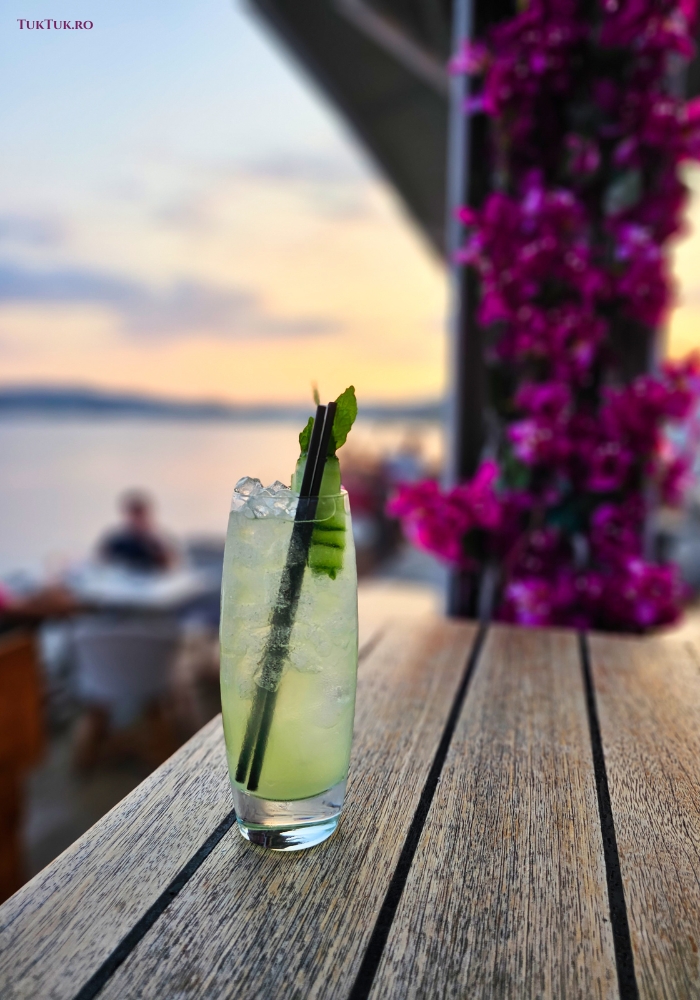
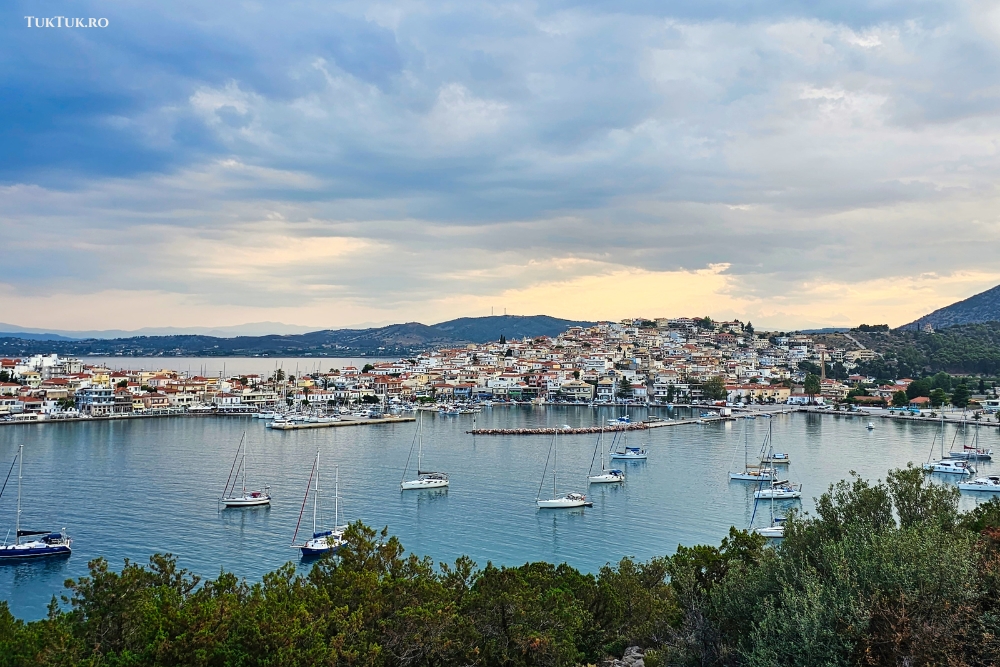
Spetses – the heroine Bouboulina and some magical moments
The sea route continued with the fourth island of the Saronic archipelago: Spetses. I hadn’t heard much about Spetses (whose name would translate to spices), and I didn’t have many expectations, so I wasn’t prepared for what was to come. The preamble was made by a stop at Paralia Zogeria, a beach on the far west of the island, a sort of “old customs” with crystal clear waters, and a taverna with a short and very traditional menu. The locals say it’s the most beautiful beach in Spetses and, as I wasn’t about to see any others, I just had to take their word for it. So: if you end up in Spetses and want to go to the beach, look for Zogeria, put a towel on the sand, and enjoy the sun!
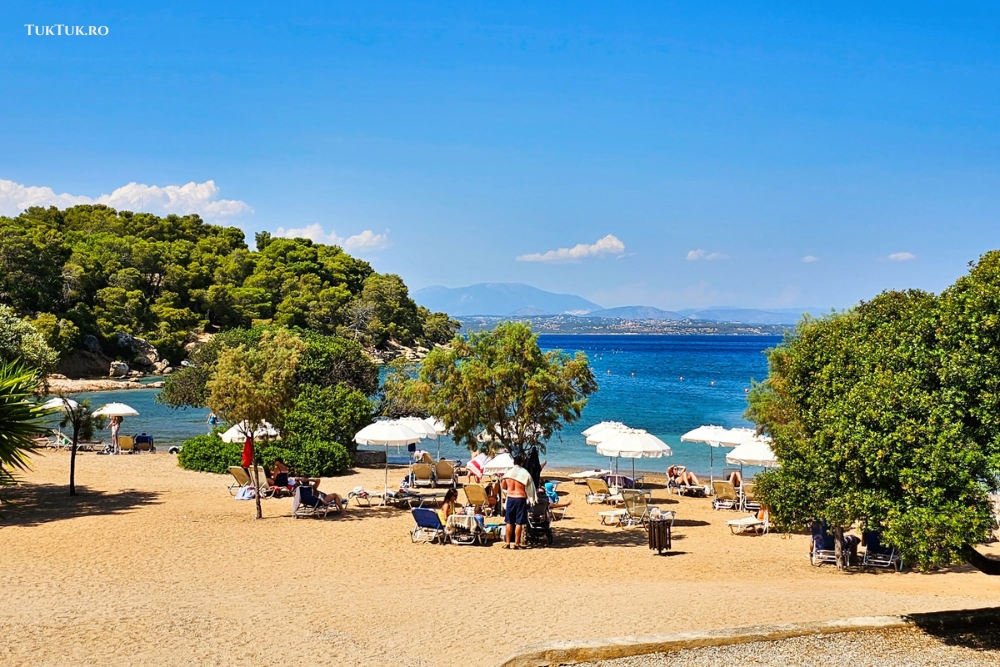
From Zogeria beach, we circumnavigated the island by yacht and ended up in Spetses Town, the capital and main town (the others being, incidentally, local jokes). We walked somewhat listlessly down the wide quay, which looked nothing like the one on Hydra, the previous Saronic island we had stopped at. A wide, lantern-lined plateau, watched over by an imposing building that I initially thought was the Town Hall. It wasn’t, but we’ll return here.
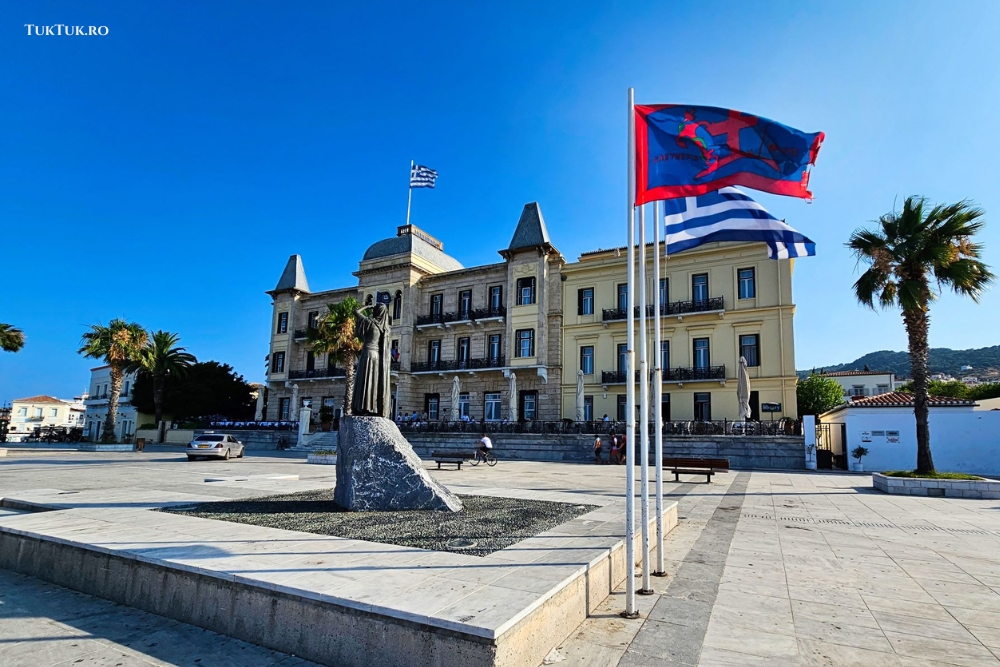
We passed the building and walked for a few minutes to reach the main tourist attraction of Spetses, the place that pays homage to the island’s heroine, the character who put Spetses in the history books, the 19th-century superwoman, the famous Laskarina Bouboulina and the house-museum that presents her deeds and life.
In other words, to understand what Spetses is all about, you must first meet Bouboulina. Born in 1771 in prison in Constantinople (now Istanbul), where her father had been imprisoned for participating in revolutionary actions against the Ottoman Empire, Bouboulina grew up with her mother, first on the island of Hydra, then on neighboring Spetses, listening to sailors’ stories and plots about a future revolution of the Greeks to free them from the Ottoman yoke.
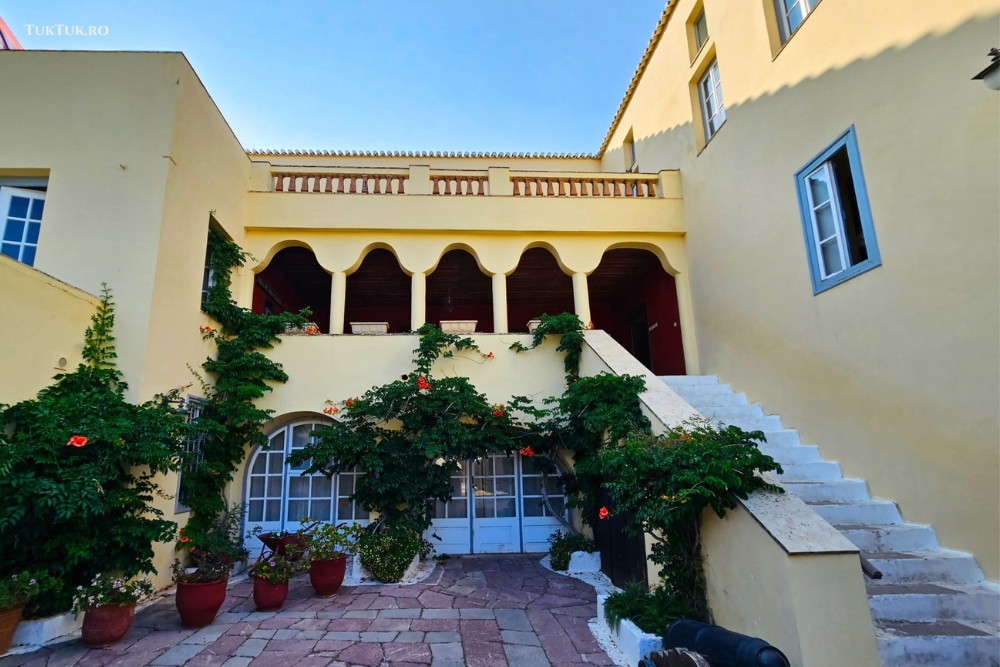
Married twice, both husbands being ship captains killed in pirate raids, Bouboulina gave birth to no less than seven children but also inherited a huge fortune from her two men. A clever woman, she enriched this fortune by becoming a partner in several shipping companies and building three ships of her own. Among these was the famous 18-gun Agamemnon, the largest vessel to take part in the Greek War of Independence.
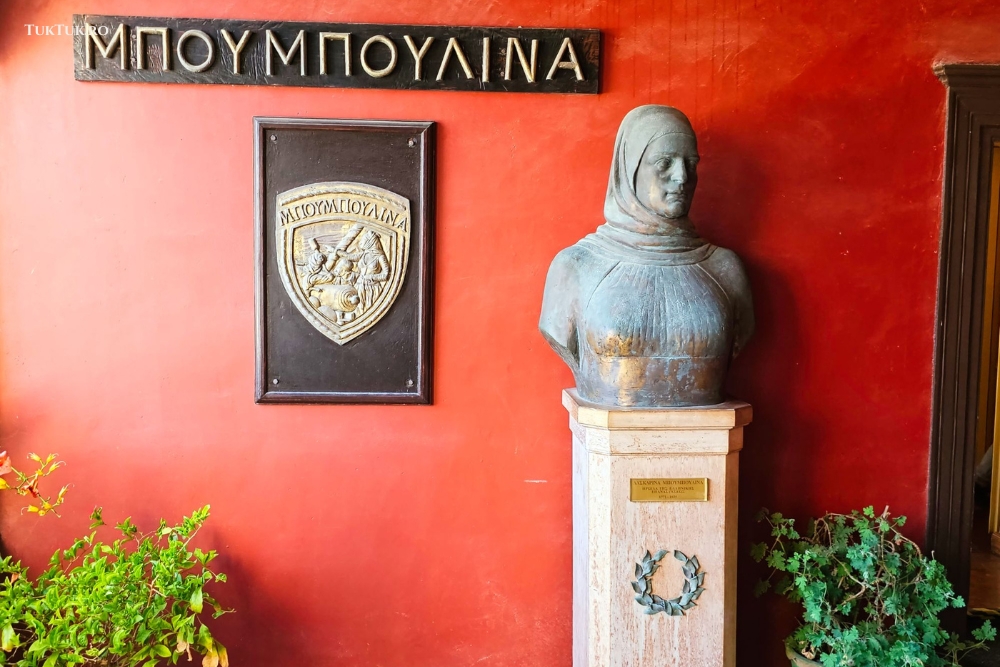
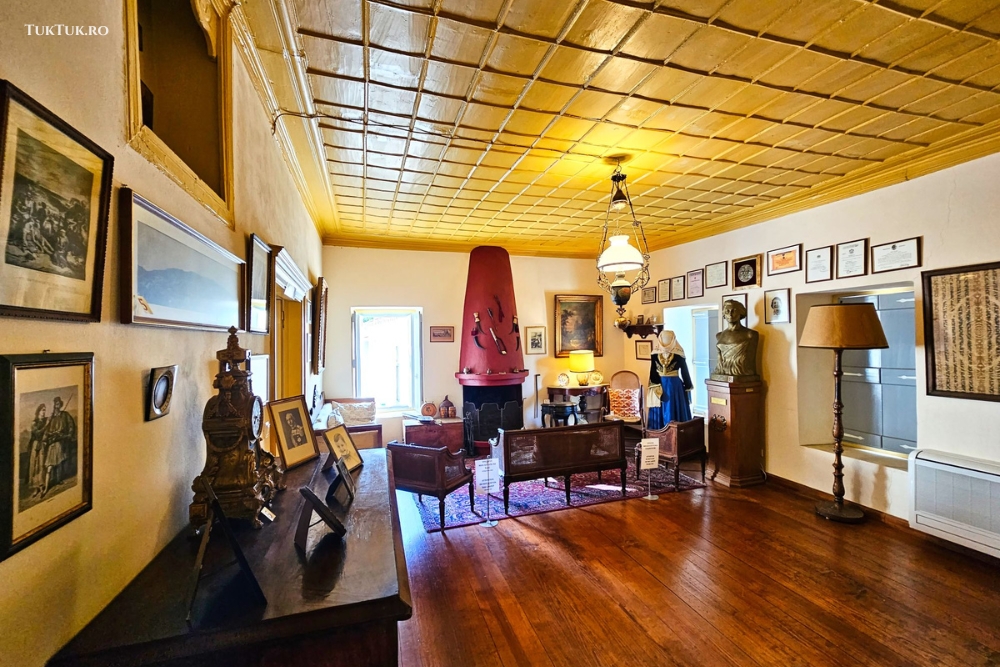
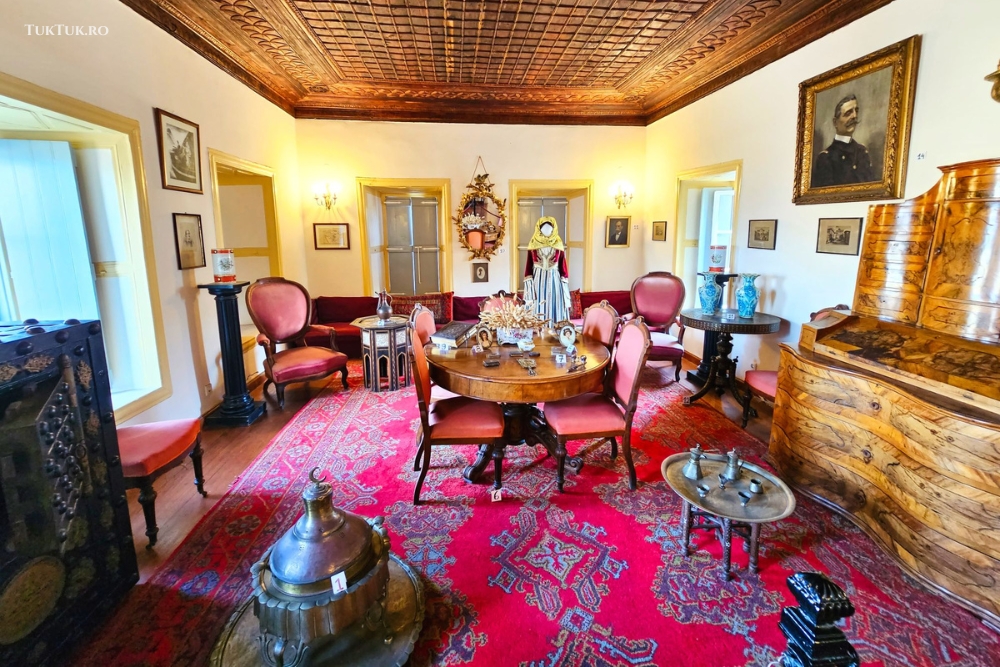
Having become a member of a secret organization spreading the idea of Revolution, Bouboulina used her wealth to build weapons and ships for her country while gathering men to fight against the Ottomans. On 13 March 1821, Bouboulina hoisted the Greek flag aboard the ship Agamemnon and launched a naval blockade against the Turks, beginning a series of actions that eventually led to the victory of the Revolution. Unjustly murdered four years later by a clansman who had come to question her about her son, who had run off with his daughter, Bouboulina was posthumously awarded the rank of Admiral by the Russian Navy, becoming the only woman in history to hold this rank. Many streets throughout Greece today bear her name, a sign of the Greek people’s admiration for her.
The Bouboulina Museum is very well organized and displays various objects, paintings, manuscripts, and letters that belonged to Bouboulina. There is an important piece of history here, especially as Spetses (along with its neighbor and ‘rival’ Hydra) was one of the islands where the flames of the Revolution that led to the birth of the modern Greek state were lit. An almost obligatory stop for anyone visiting Spetses. I ticked it off and returned to the harbor area, where the guide started telling me about the building earlier, which was not the Town Hall but… a hotel.
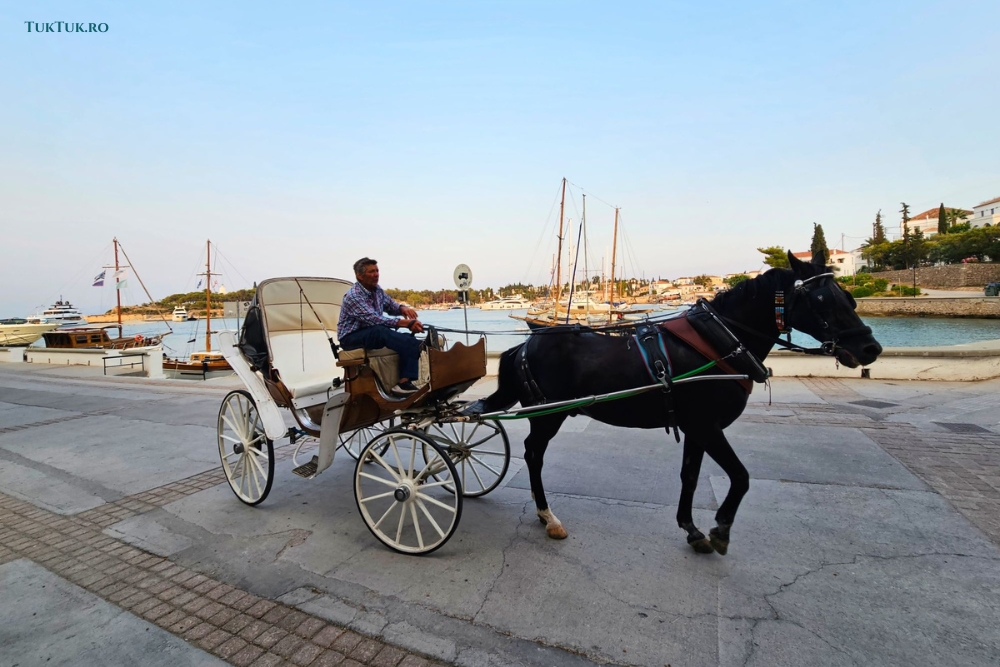
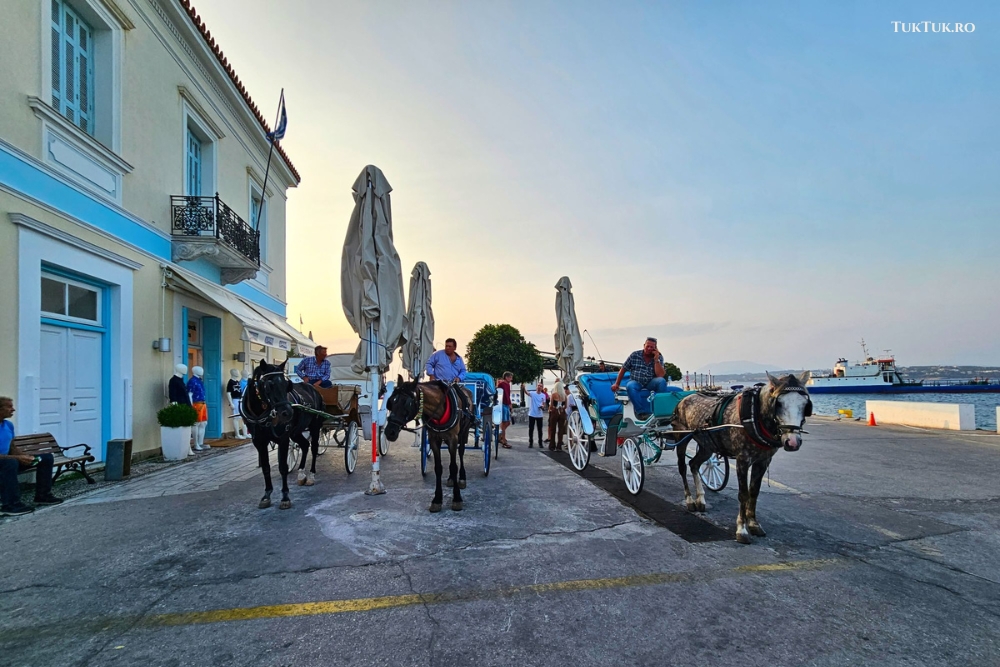
But before that, I had to notice one thing: no cars in Spetses either! No, it’s not the restriction of Hydra – I mean, here you see taxis, buses, mopeds, and bikes. But you don’t see cars. So, if you plan to Spetses and rent a car, abandon the idea and think about a coach instead. There are no mules here, but plenty of horses are ready to carry you around if you don’t want to use your legs.
The Poseidonion Hotel was opened in 1914 by Sotirios Anargyros, a visionary philanthropist responsible for much of Spetses’ development. The building has, over time, become the island’s landmark, living out its history with high society visitors, royalty, and wealthy Athenians who happily book rooms here. We were photographing the hotel from the outside when an elderly gentleman, elegant and charming, dressed in a Polo shirt and wearing a navy scarf around his neck, smilingly interjected, asking us what the occasion was in the hotel’s ‘courtyard’.
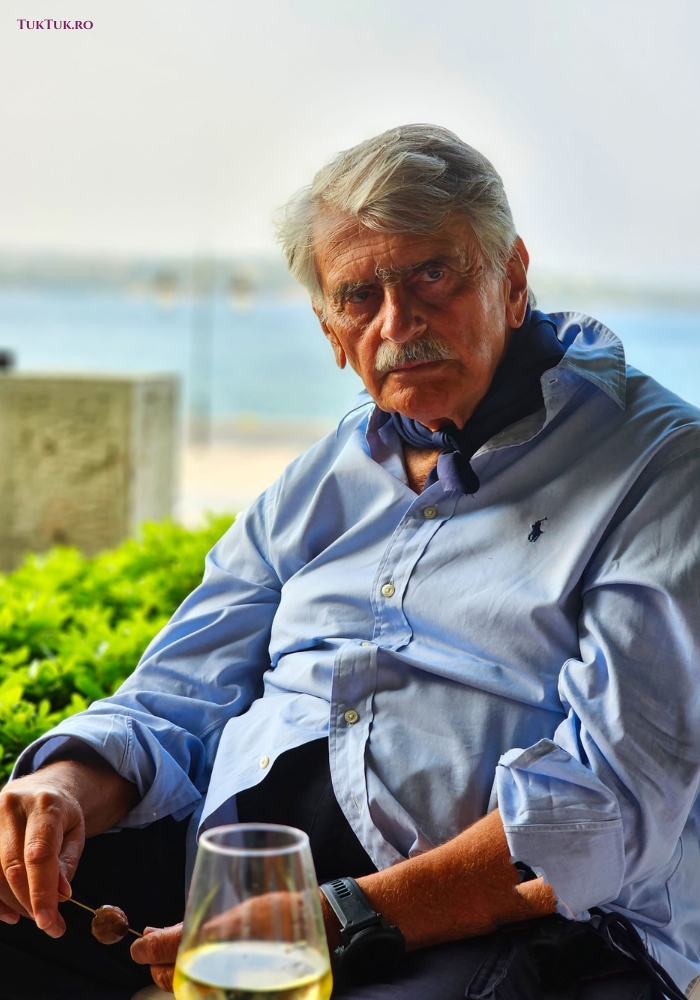
The gentleman is Manolis Vordonis, owner of the Poseidonion Grand Hotel, a leading chairman for many decades in the Greek and global shipping industry (he owns the Thenamaris shipping company), a specialist in physics, theory, and philosophy of science, with studies and research in systems analysis, control, cybernetics and modeling of complex systems. I made this presentation long because, after inviting us into the hotel garden for a cocktail, this character created a fascinating half-hour, talking with infinite charm about the history of the island and the hotel, tourism, the symbolism of Poseidon, and other things that worked like a magic wand, one that triggered my love for Spetses. A place that he himself defined as one that, if you come once, you’ll definitely want to return to.
Meeting Manolis Vordonis was one of those unexpected moments in your life that filled you with almost indefinable happiness. But… wait! That was just the beginning.
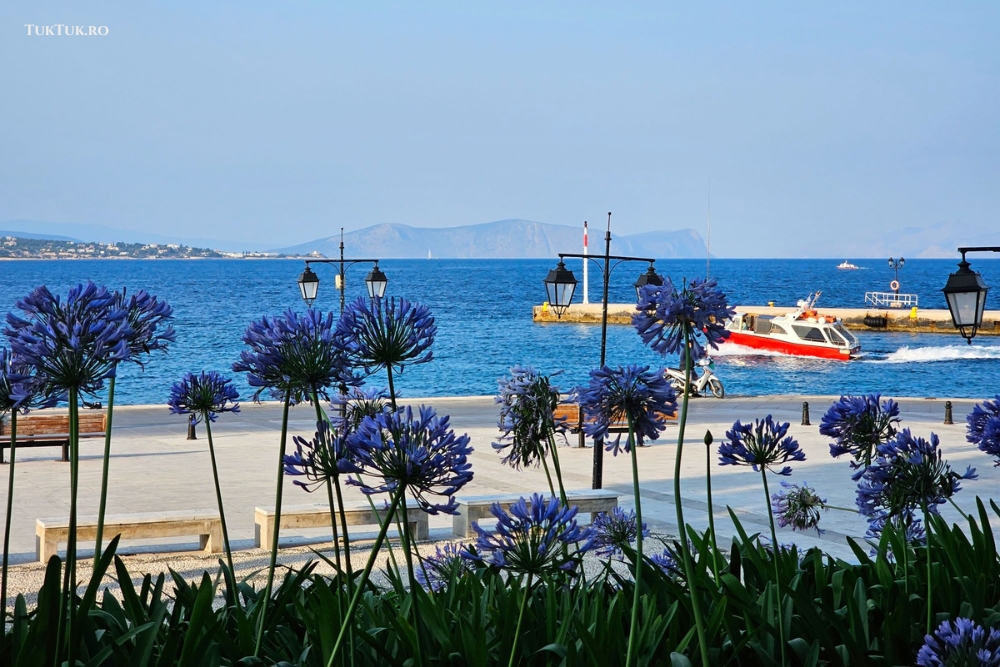
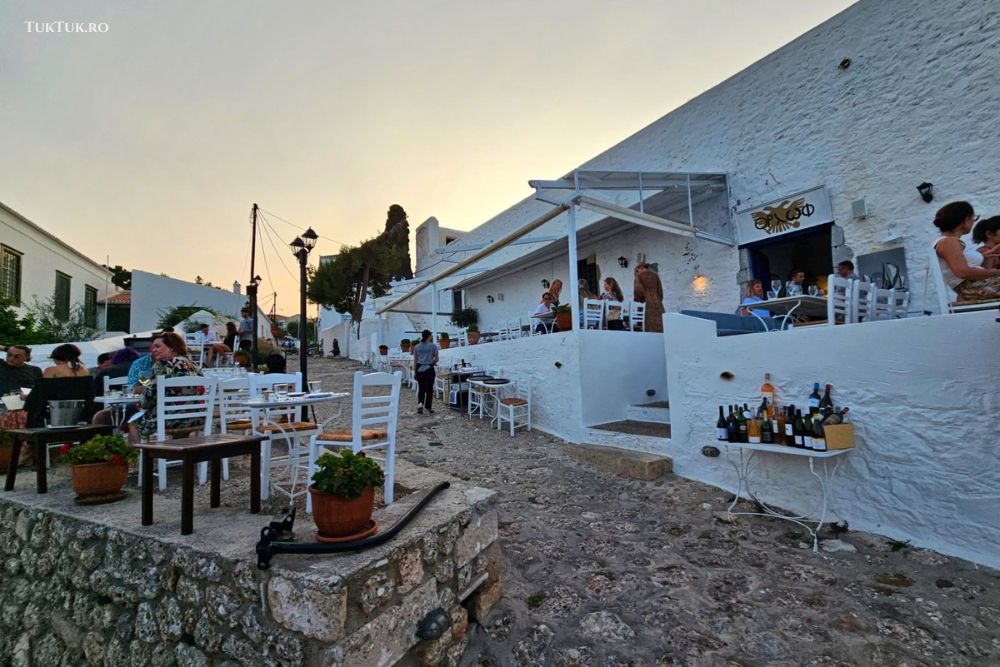
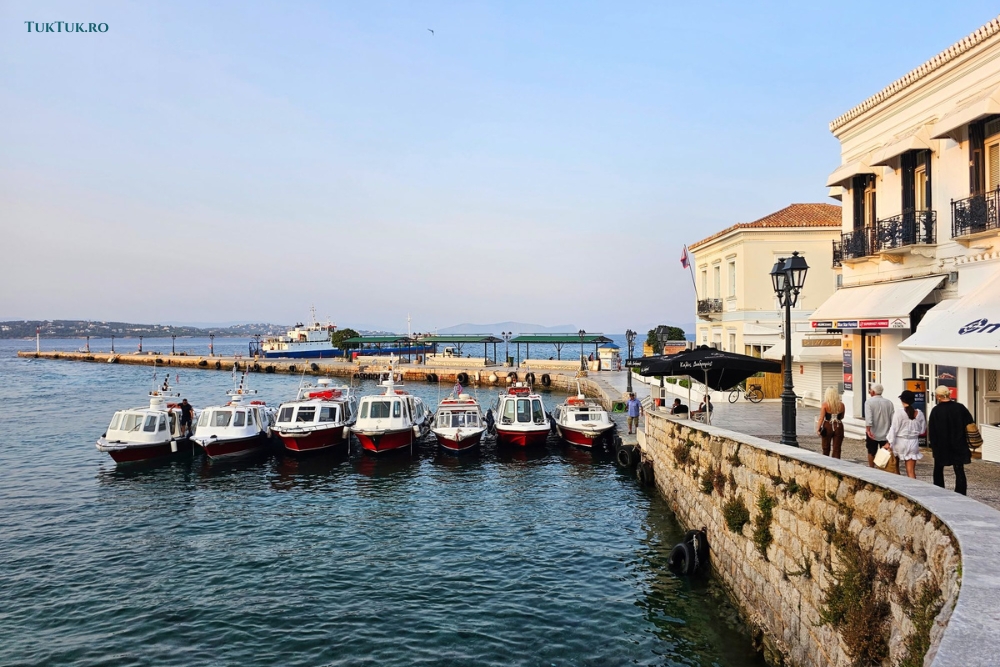
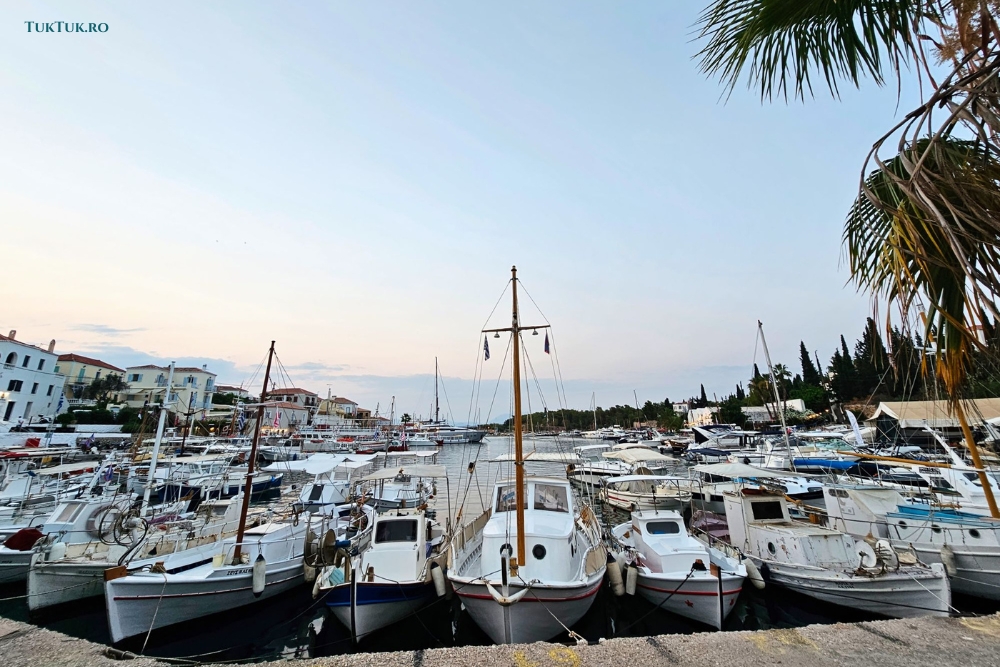
We leave the terrace of the Poseidonion and take a carriage to the other side of town. Two more steps and we reach the inner square of a small church, where on a stage set up, a philharmonic is being urged by a soloist to sing divinely in front of a small audience. I quickly find out that it’s a concert by a famous singer from Greece for the baptism of her son, the godfather being the owner of EasyJet (also in the audience). So beautifully did that orchestra play, so beautifully did the soloist sing, accompanied by the buzzing of cicadas, at dusk, as the moon was preparing for the show, to the backdrop of Sinatra’s “Fly me to the moon“, that I wrote this second Spetses moment in gold letters in the book of all-time tourist “bliss”.
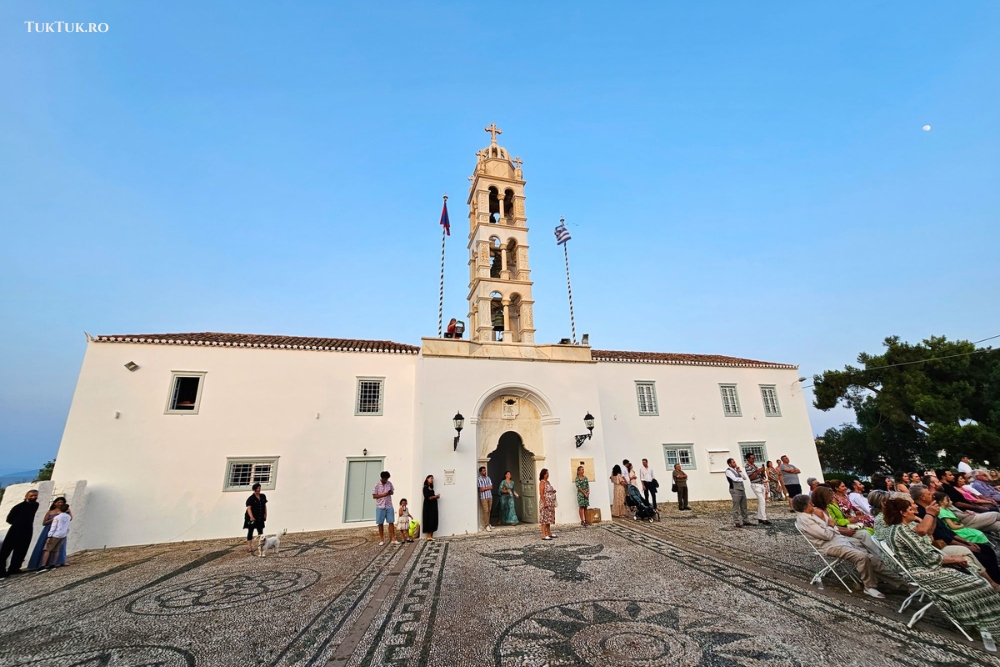
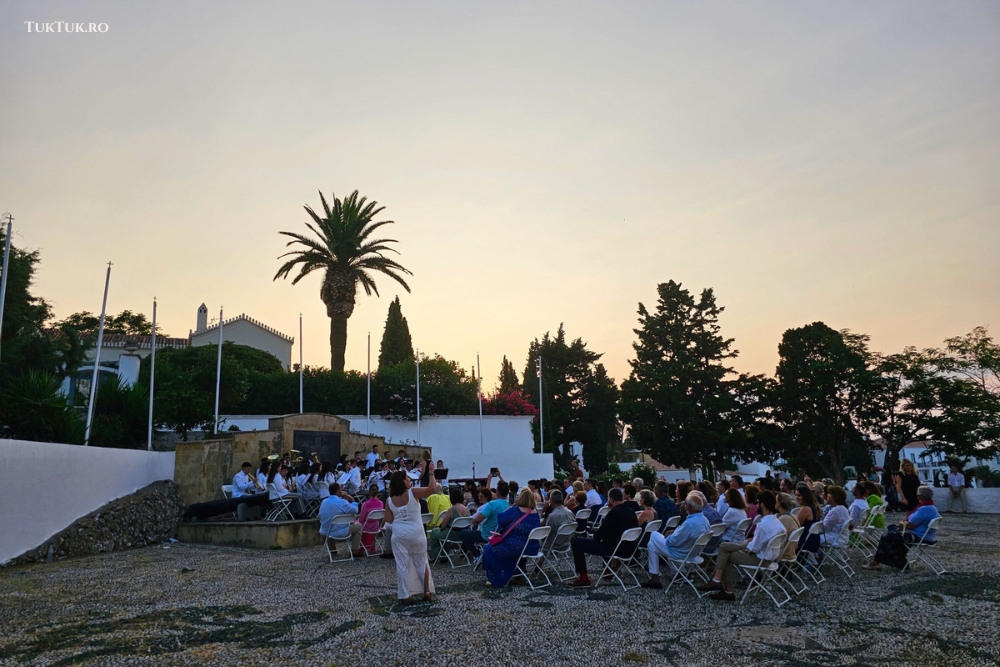
But… wait! You thought we were done? I leave the ad-hoc christening (without seeing the baby), and after a 10-minute walk along the cliff, I arrive at the Hono&Lulu resto-bar, where I have the best gourmet dinner of the last hundred years. So good that we all call the chef and tell him he makes Champions League food. What did we eat? Check out the menu in the restaurant’s link, and, if you get there, trust that everything, but absolutely everything, is brilliant. Plus, although there was no one on the club’s terrace at first, after dark, the atmosphere came fully alive, with the 70s-80s music literally inviting dancing in the small room inside, lit on disco principles and made more dazzling by the girls who moved accordingly.
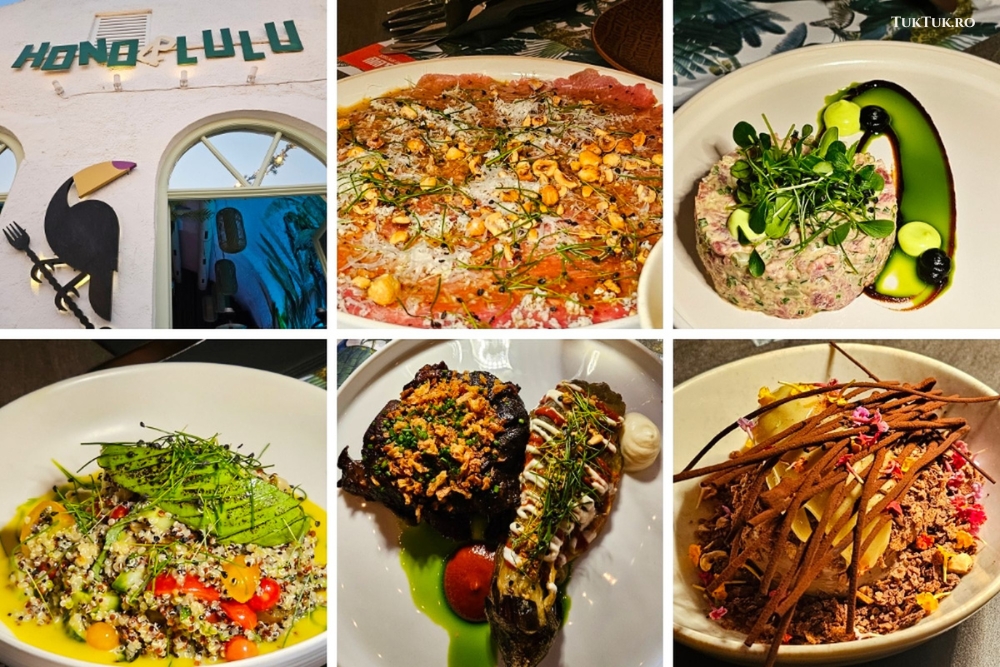
This was ‘my’ Spetses, and I don’t know whether to speak from documentation about what a holiday here would mean more. I’ll leave it at that, with the idea that this was my favourite Saronic island of the five and that I wish – not just to go along with what kir Vordonis said – that I could go back. Perhaps, one day, I will.
Poros – the island of Poseidon
Poros was the fifth (and last) island in the Saronic archipelago that I landed on. Few people know that Poros consists of two islands, separated by a very narrow channel (the Poros Channel), the southern appendage being called Kalavria, while the main island is called Sferia. However, despite being a sort of David and Goliath, both islands are home to a relatively equal number of inhabitants – around 4000 each.
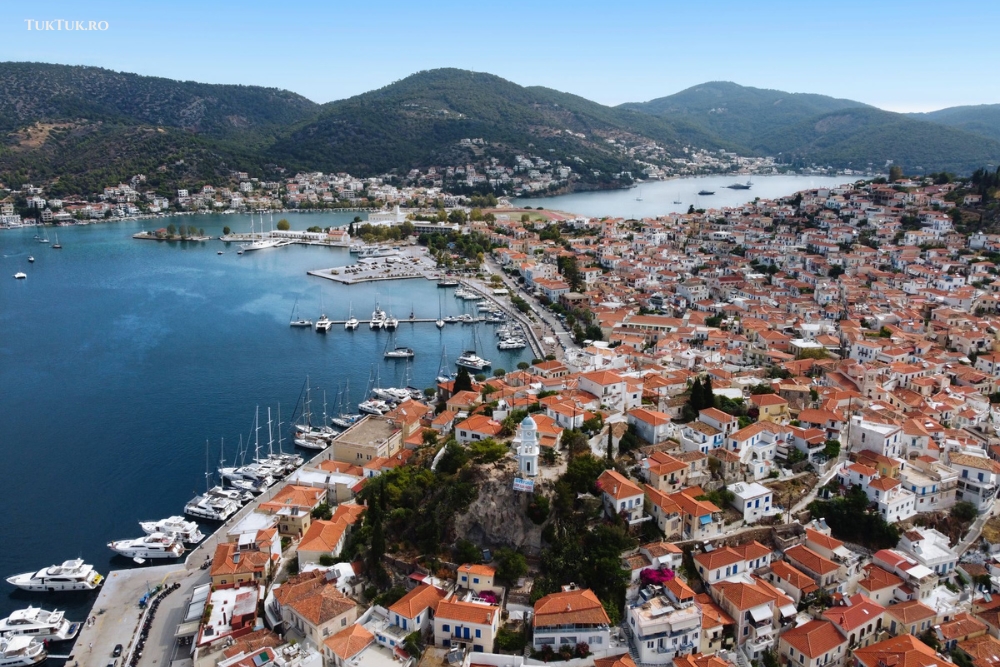
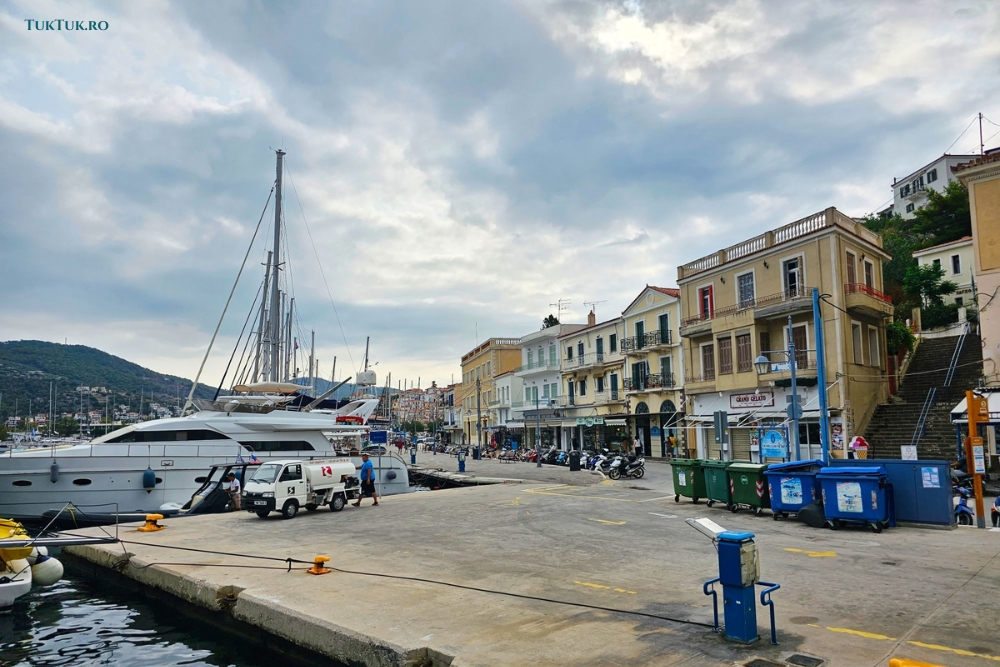
Poros has rich history, making it one of Greece’s interesting islands. In ancient times it was called Calauria and was considered a place of great religious importance. It is said that Poseidon was born on Poros, which was enough for the island to become a place of pilgrimage for those who came to offer sacrifices and offerings to the sea god. In Byzantine times, Poros was a place of refuge for Peloponnesians trying to escape the invading Goths, so the island quickly became a thriving place.
Like other islands in the Saronic archipelago, Poros played an essential role during the Greek War of Independence in the 1820s, with the first major naval battle (and the first crucial victory for Greek forces) occurring here.
Poros was also the birthplace of several major Greek personalities, such as Admiral Andreas Miaoulis, who led the revolutionary naval forces, and George Seferis, Nobel Prize-winning poet.
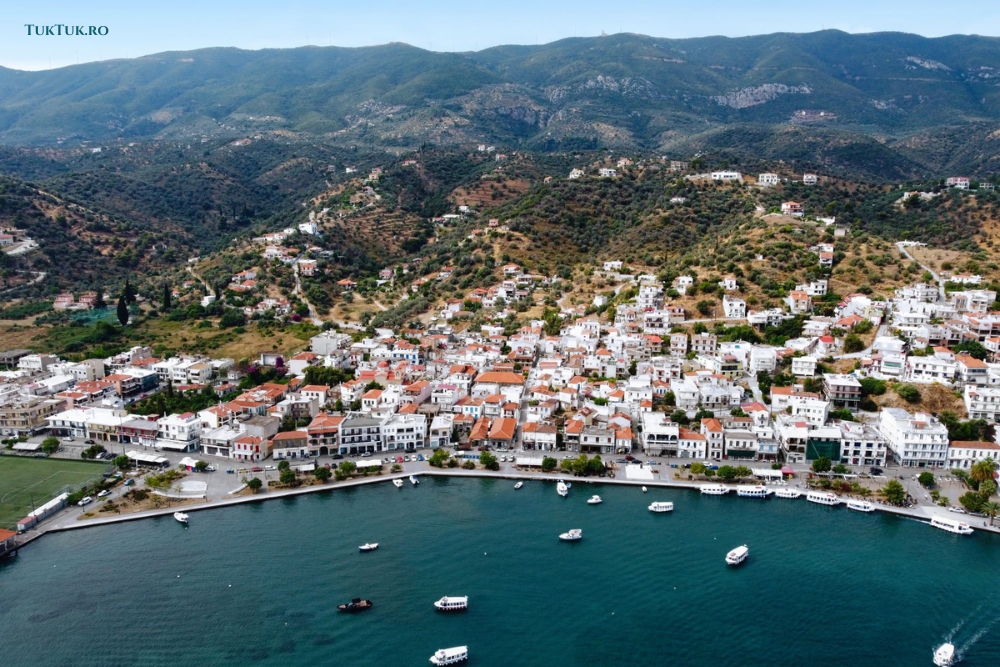
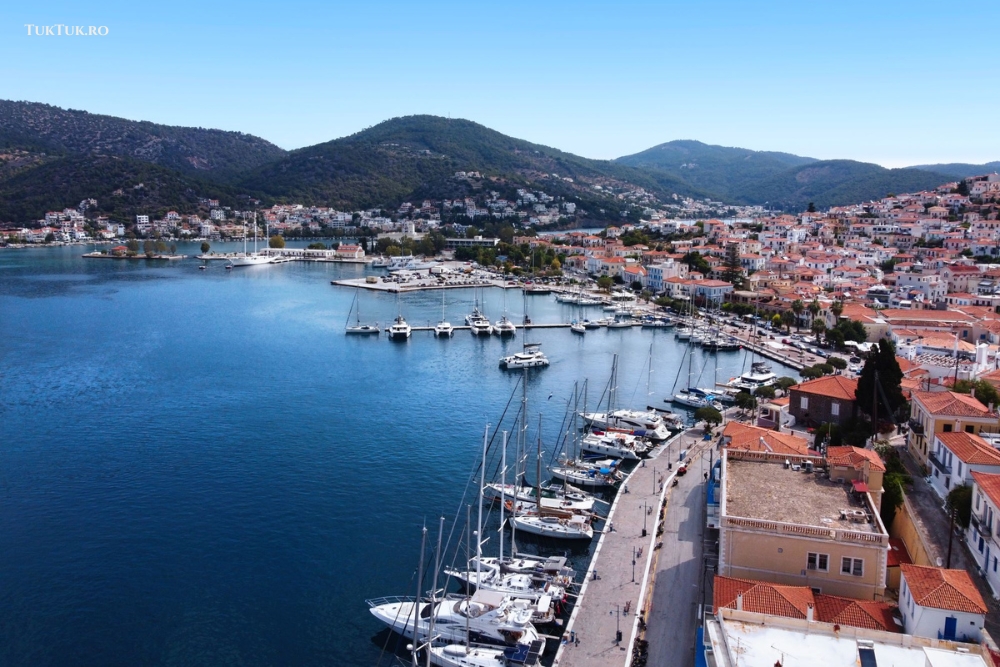
So in terms of history, Poros has a lot to boast about. Touristically speaking, we also heard nice things. Admittedly, in the three hours I spent walking around the capital Poros Town, I didn’t get the vibe Hydra or Spetses gave me. Still, the town has its own charm, with narrow streets in the old center where art shops, pastry shops with delicious food or ice-cream parlors inevitably attract everyone.
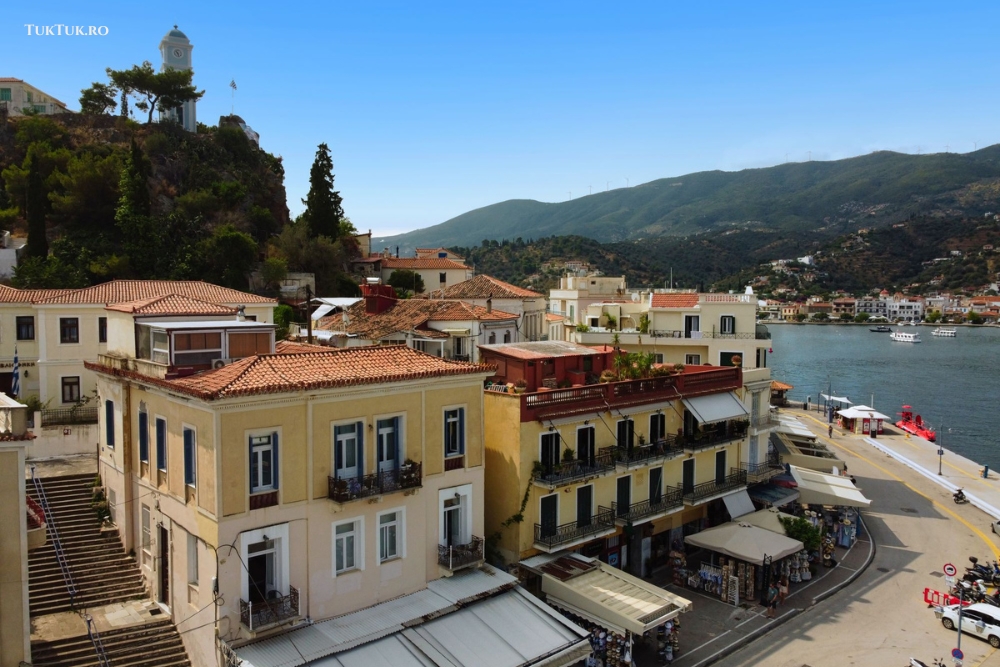
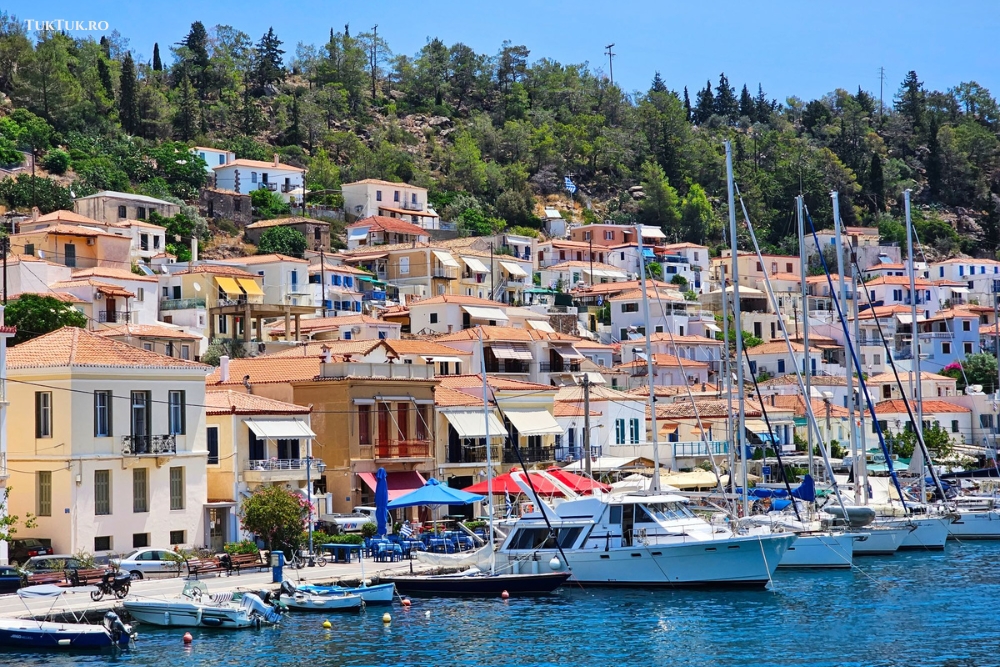
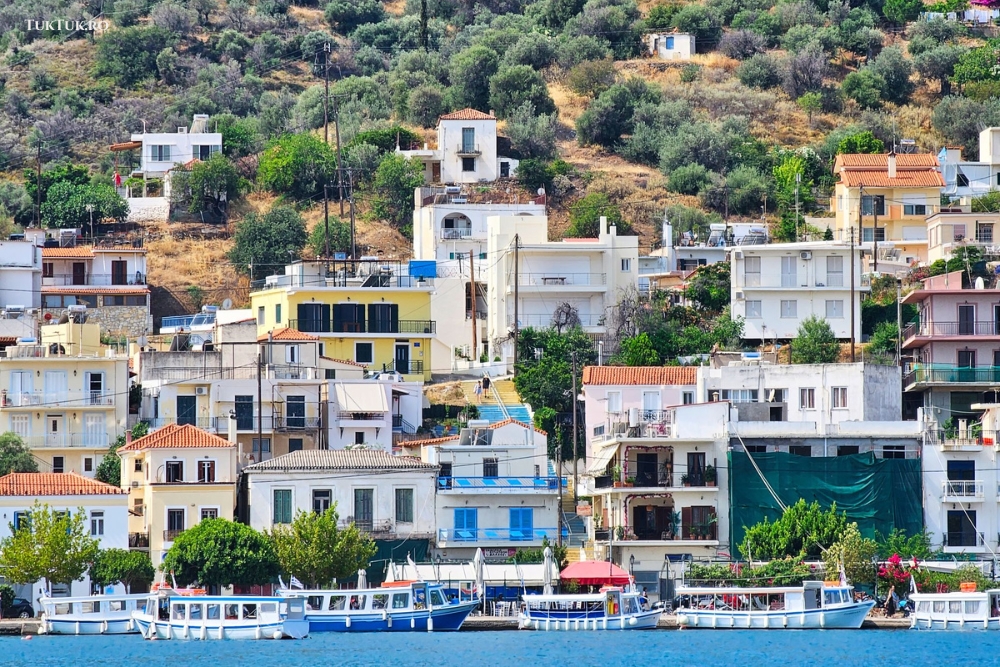
The white houses accentuate the capital’s beauty, contrasting with the pinks, reds, and oranges of the bougainvillea and hibiscus bushes. The beautiful neoclassical clock tower painted light blue, was built in 1927 and watches over the city from its highest point, visible from virtually everywhere. The hosts say that if you climb the tower, you can enjoy magnificent views of the mountainous Peloponnese coastline and, as a bonus, a breathtaking sunset.
Poros Town’s sights include the Archaeological Museum (in Korizi Square), the Public Library, the church of Agios Georgios (with frescoes by the famous Greek painter Constantin Parthenis), and the gorgeous Villa Galini, perhaps the town’s most beautiful house, once visited by writer Henry Miller.
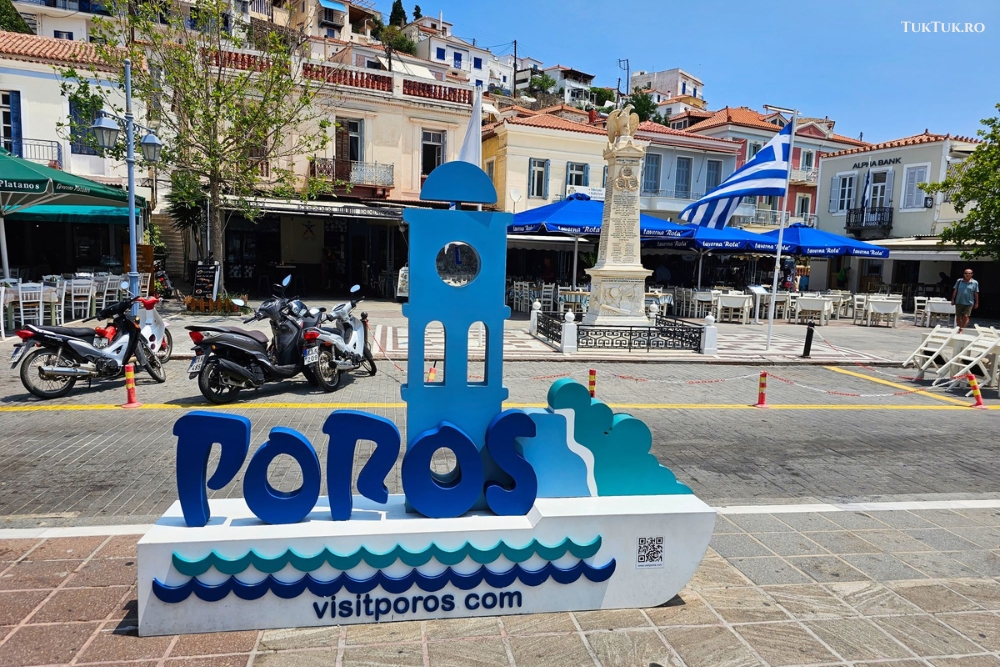
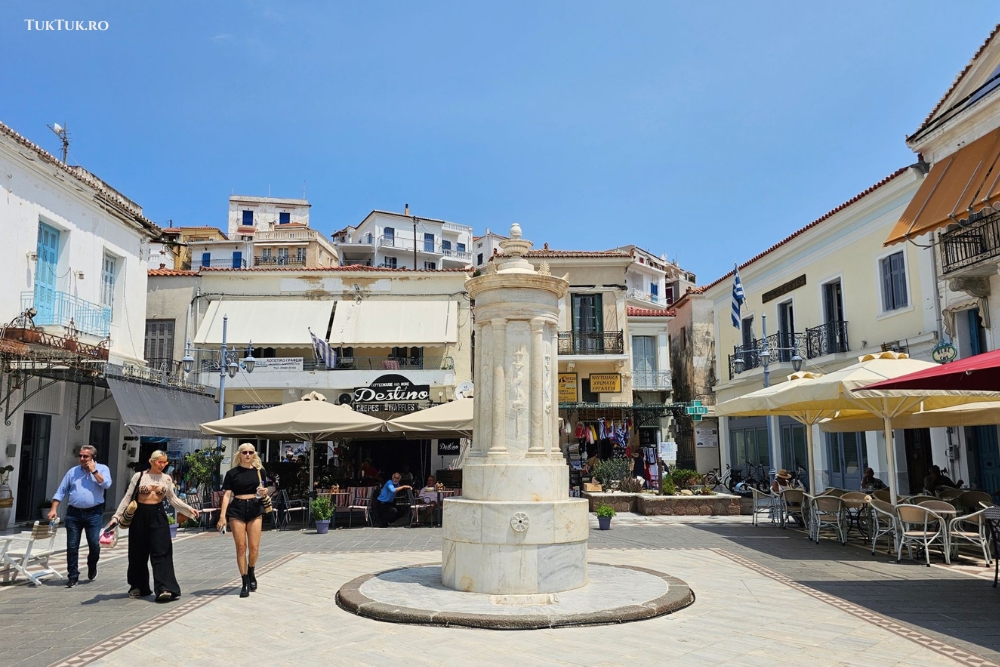
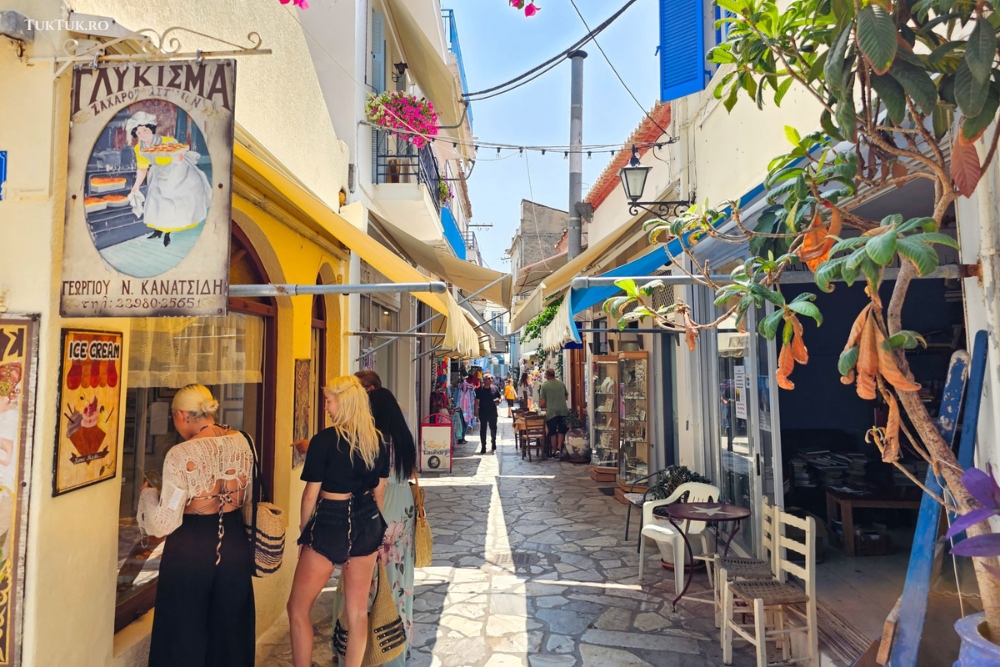

As for the rest of the island, although I didn’t have time to get to it, the Temple of Poseidon, located in the north of Poros (and dating from around 520 BC), is a must-see if you plan to spend your holiday here. The Lemon Forest, Zoodohos Pigi Monastery, and Panigitsa Chapel are also worth a visit. Poros also has some beautiful beaches, with Askeli, Monastiri, Kanali, and especially Love Bay among the recommendations we hear from hosts.
This was my yacht trip around the Saronic archipelago. Five dreamy places that could turn into as many holidays spent in blue-white scenery, with good food and a luxurious atmosphere, in gorgeous settings caressed by the gentle waves of the Aegean Sea and blessed by the benevolence of the ancient gods. Take a boat, whether it’s called a yacht, catamaran, or sailing boat, and let yourself be carried among the Greek islands to savor Greece’s jewels from a different perspective!
You may also like: Tourist attractions in Evia. What to do and see on Greece’s second largest island

